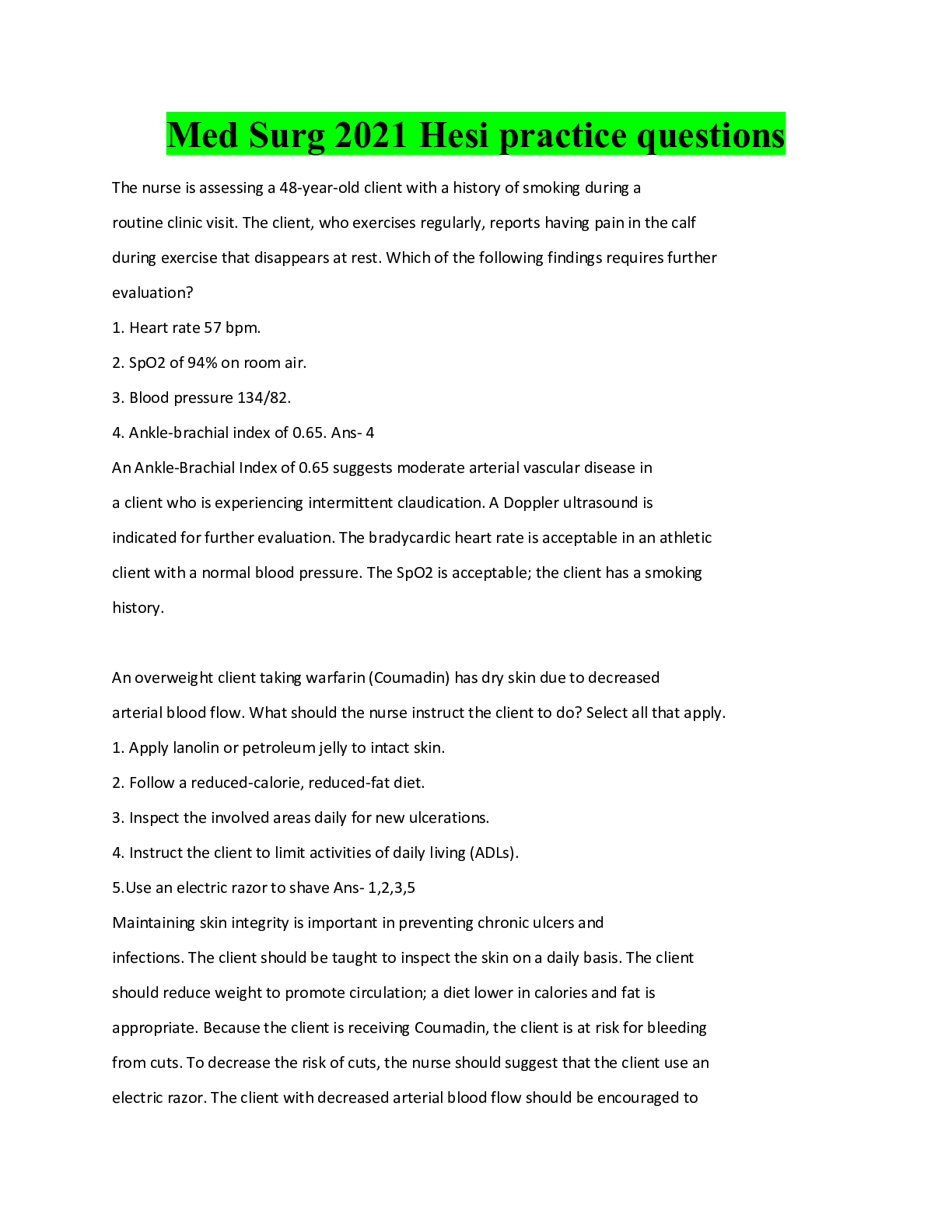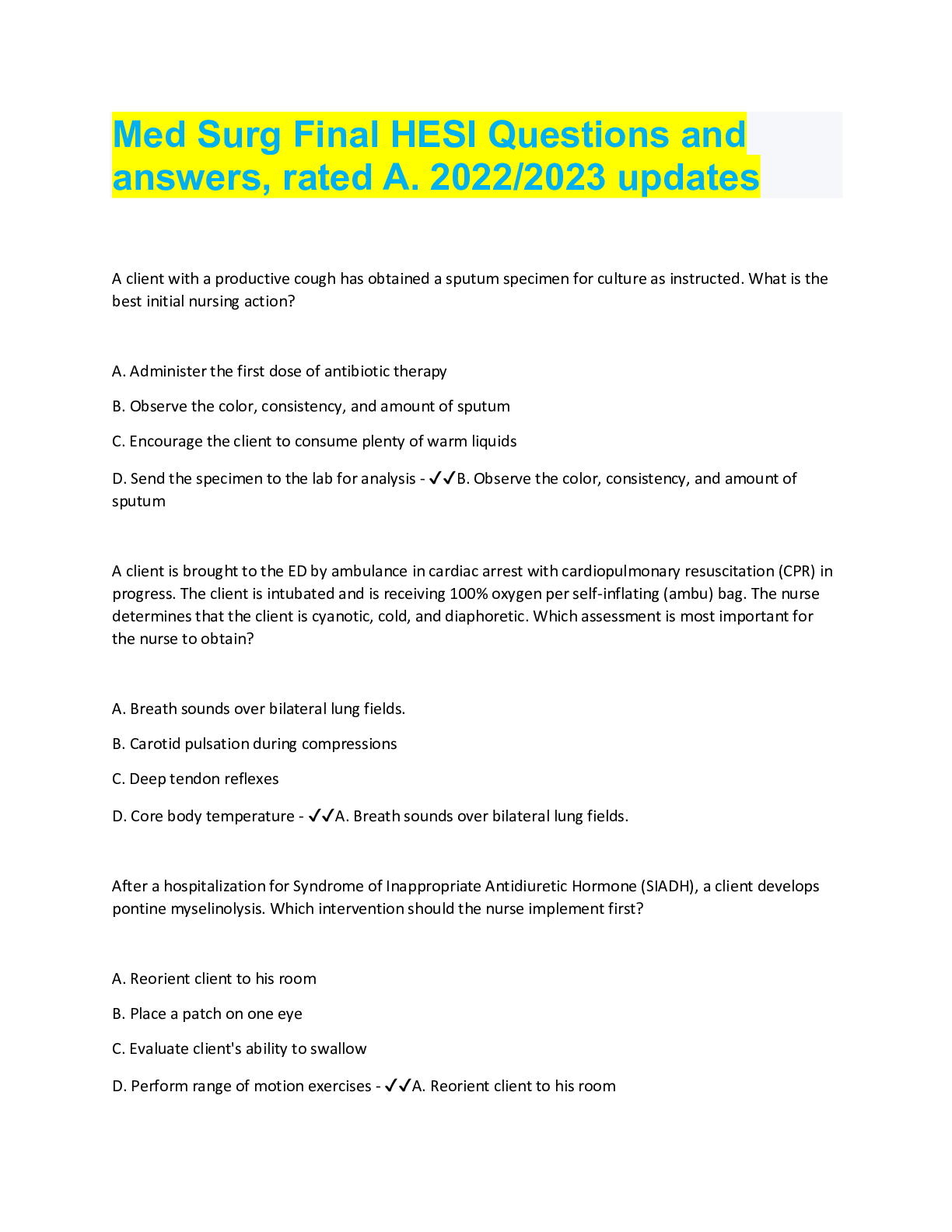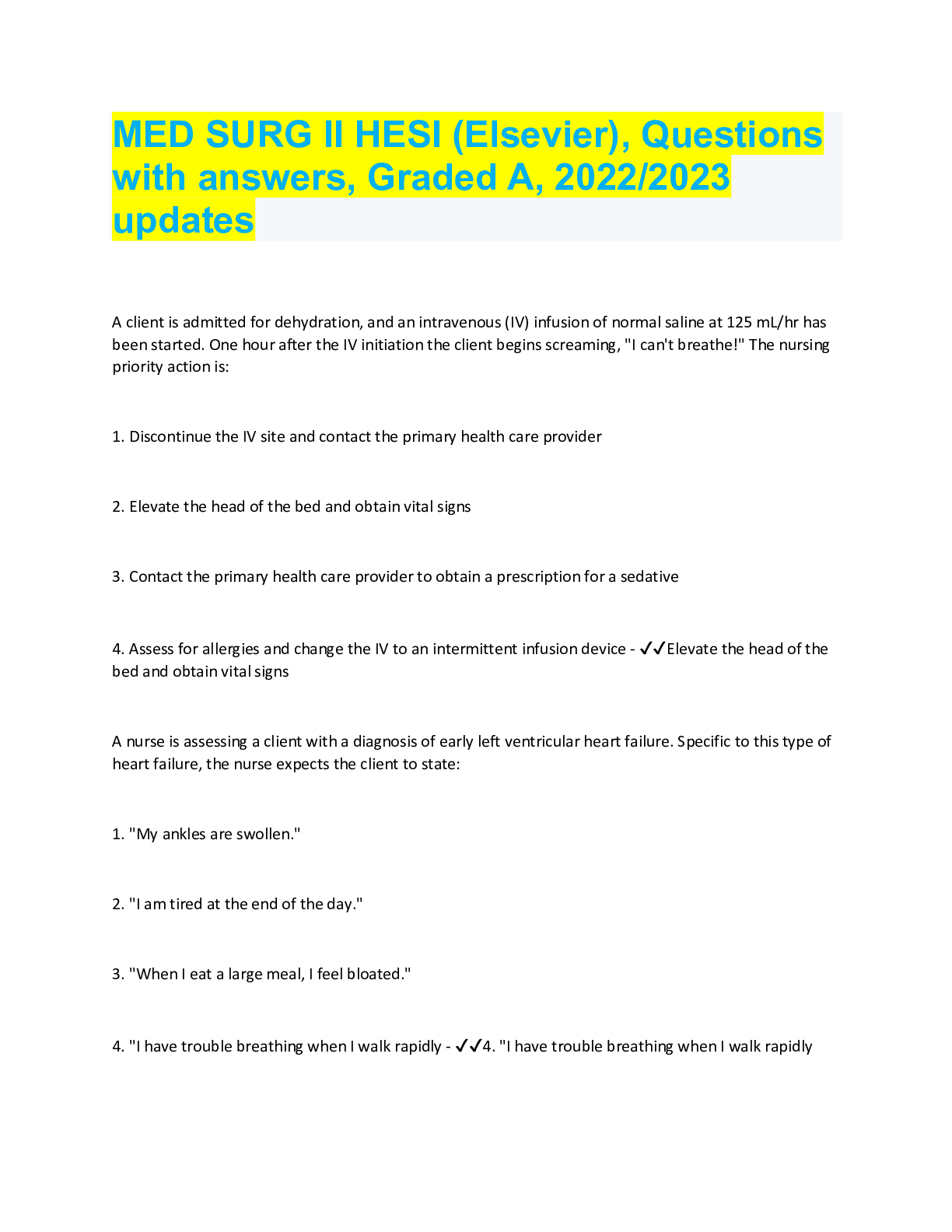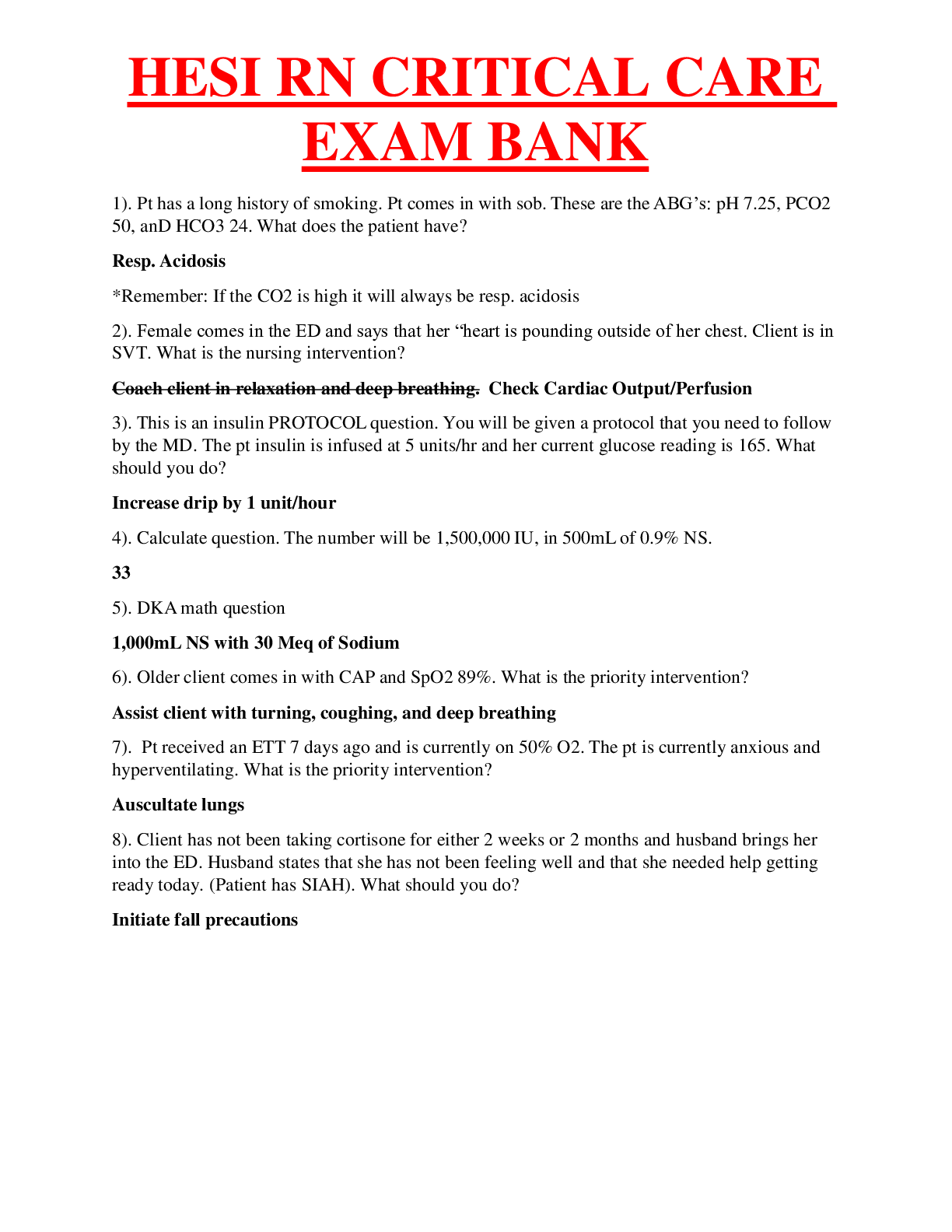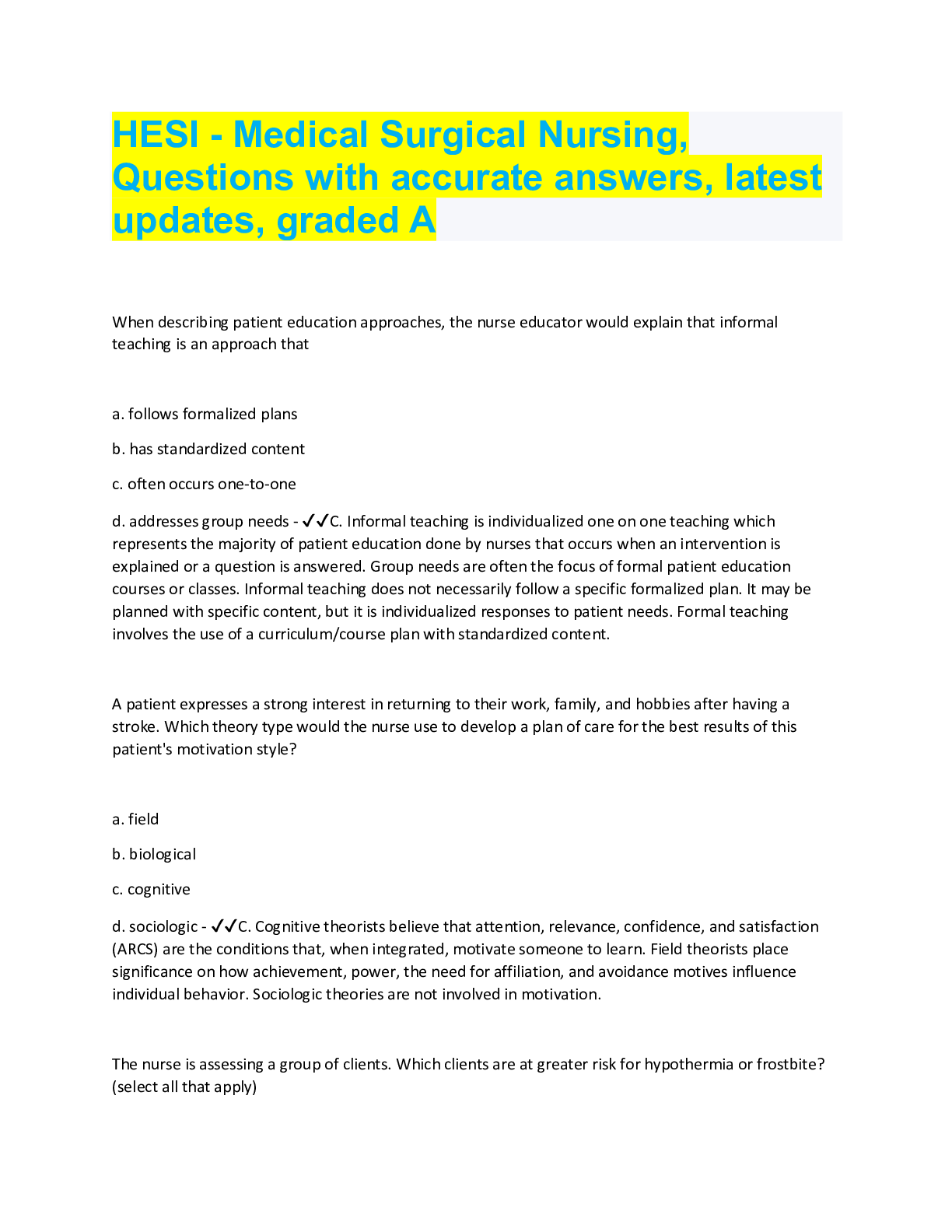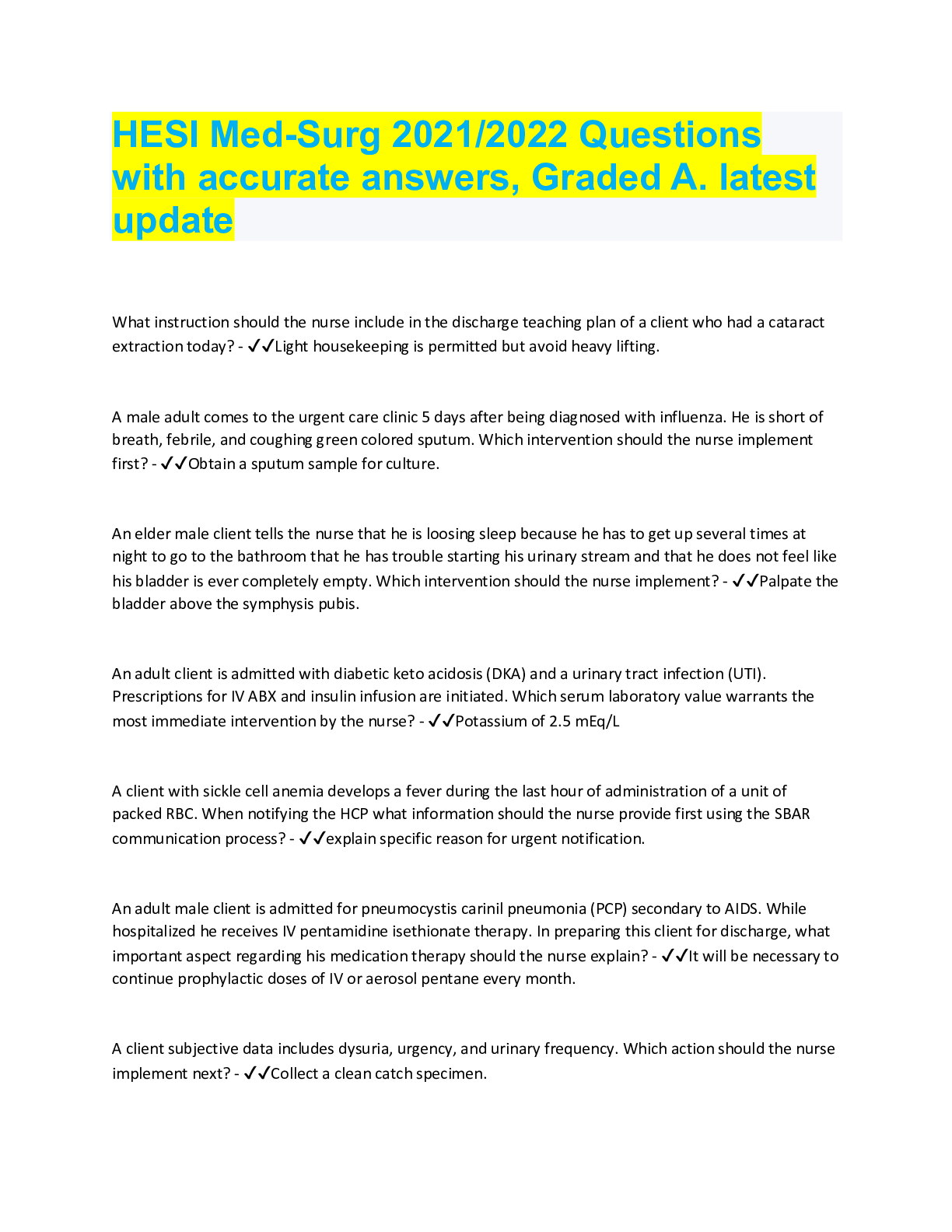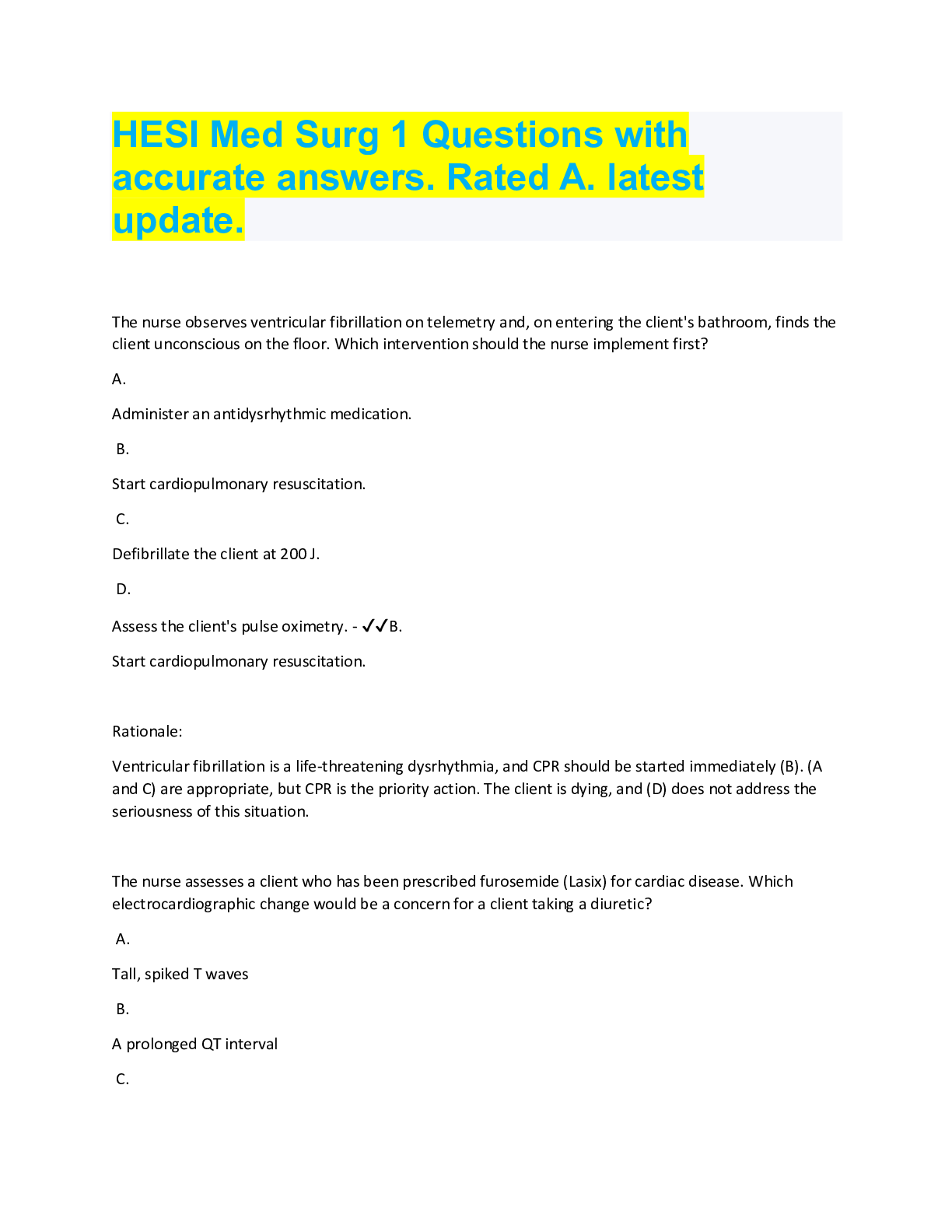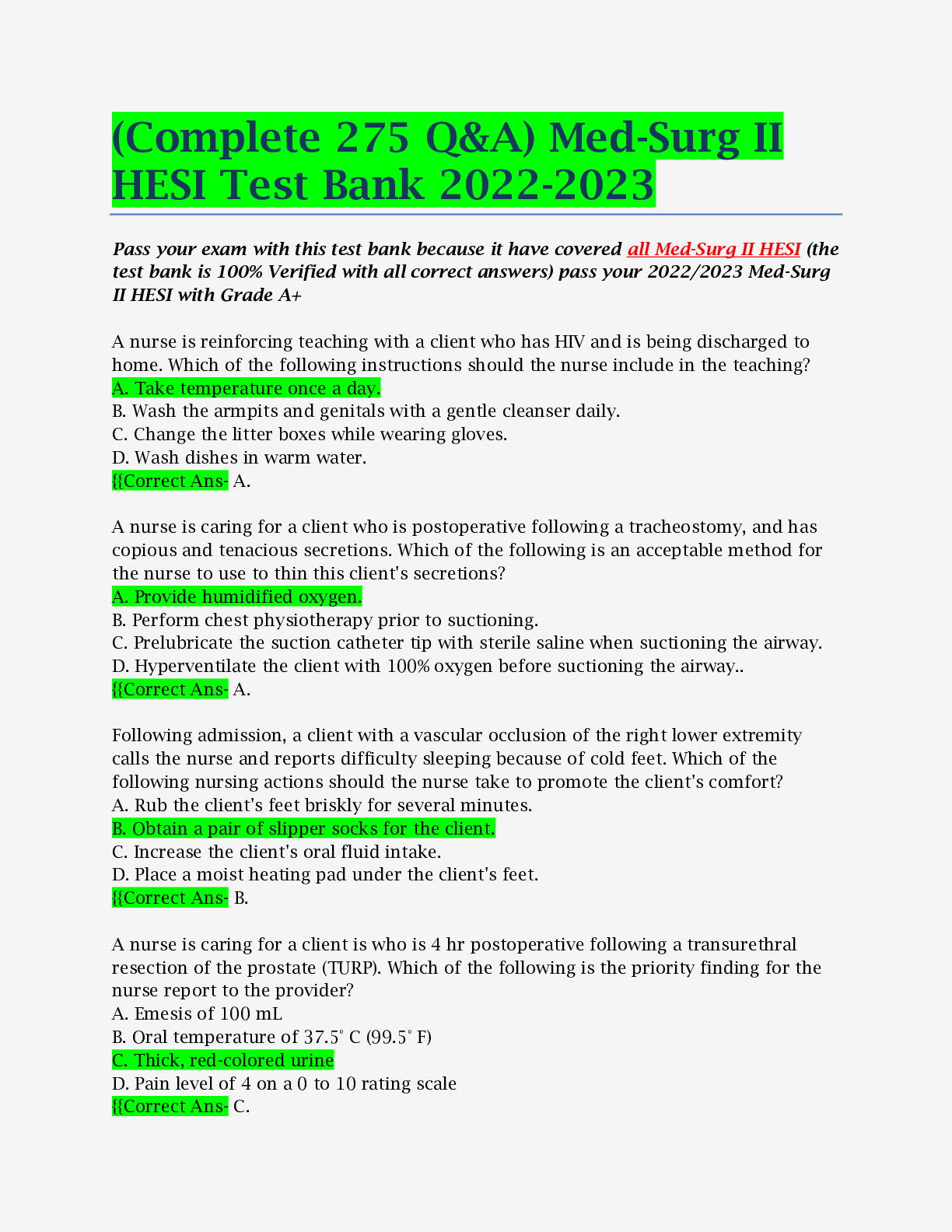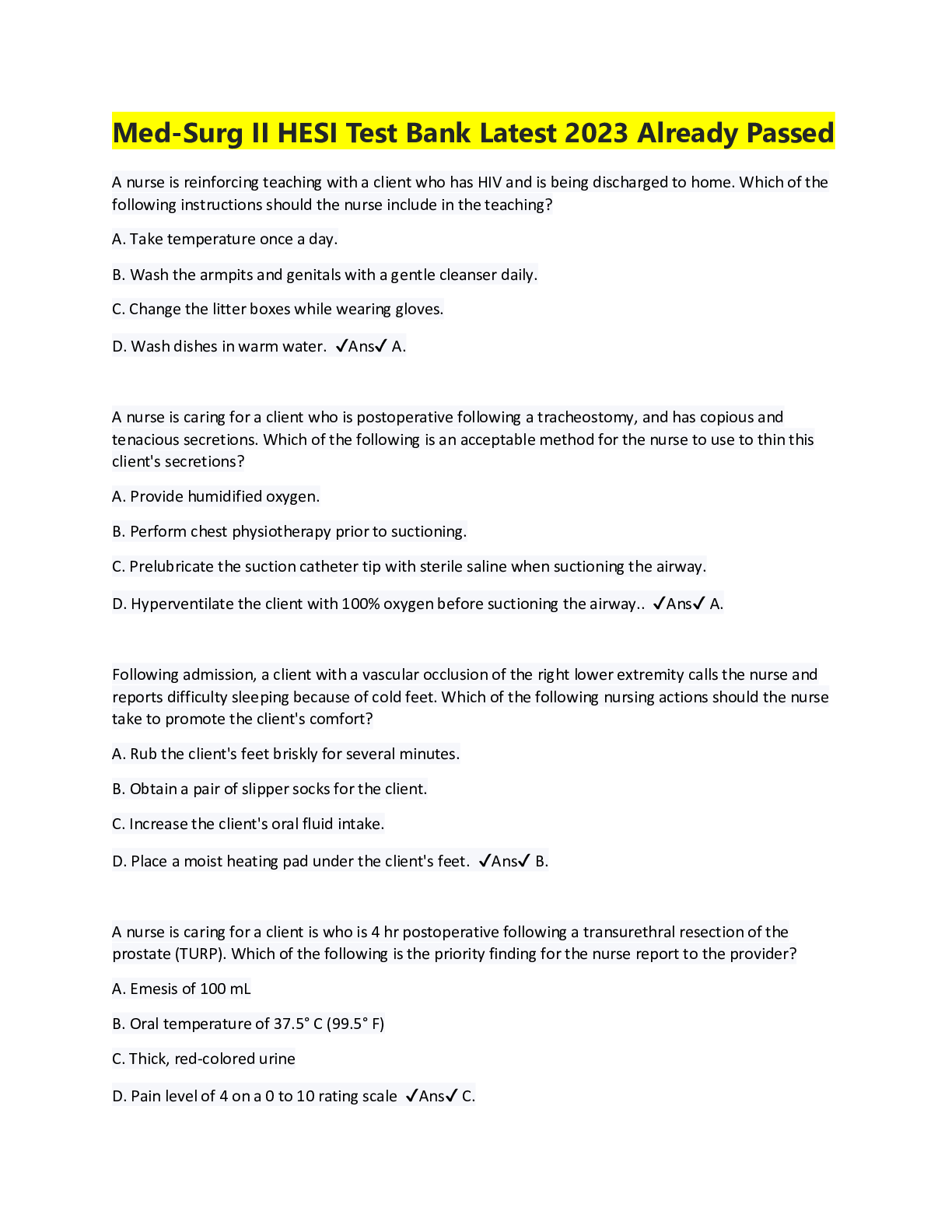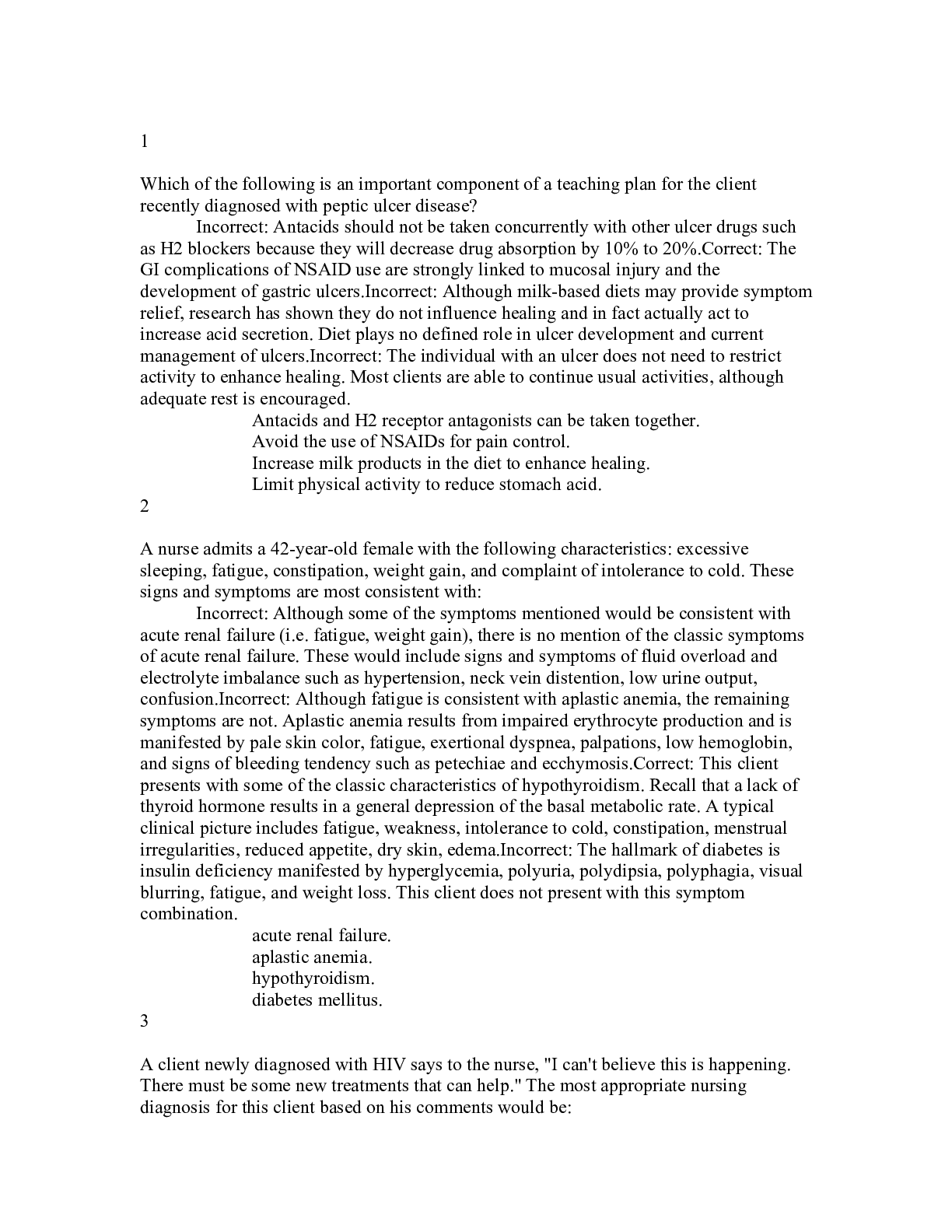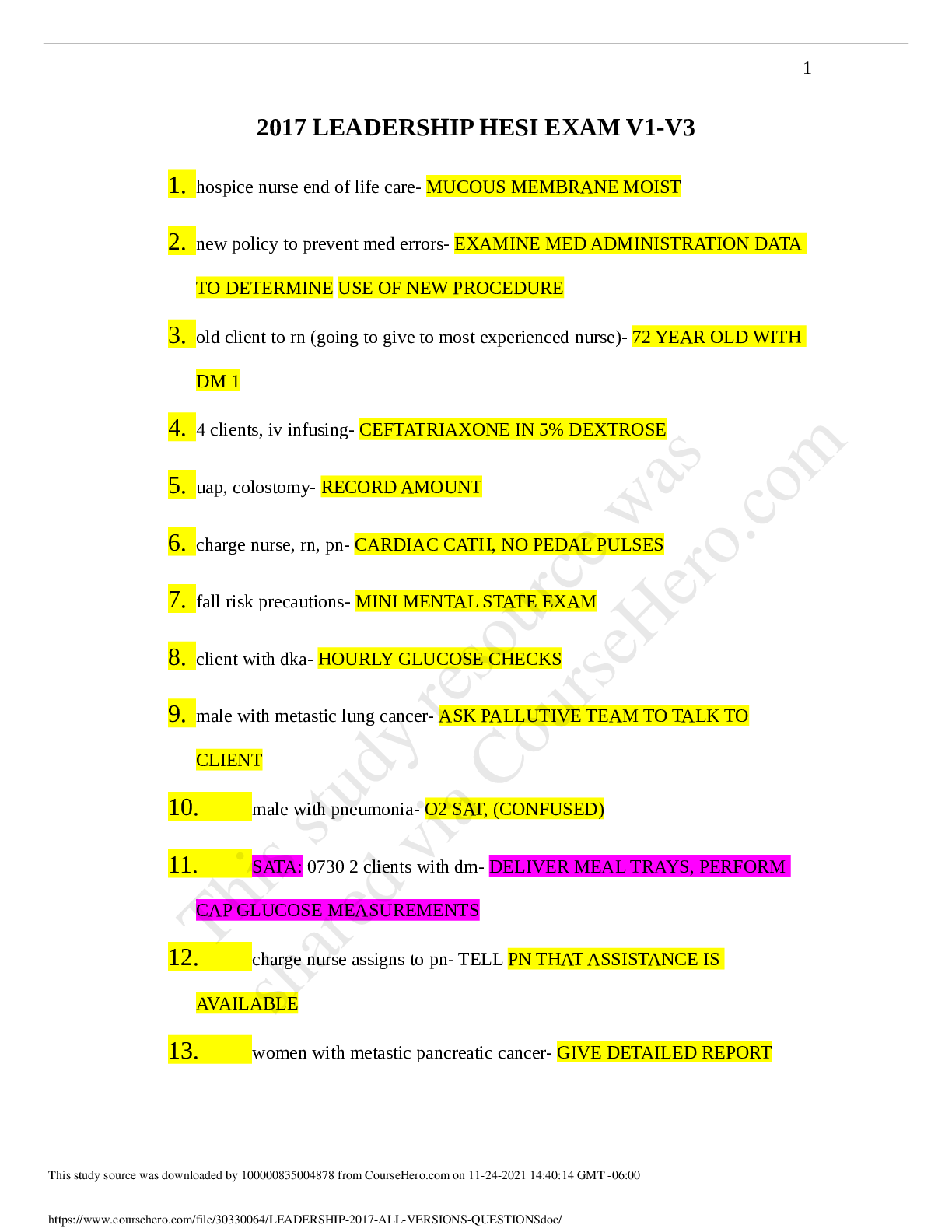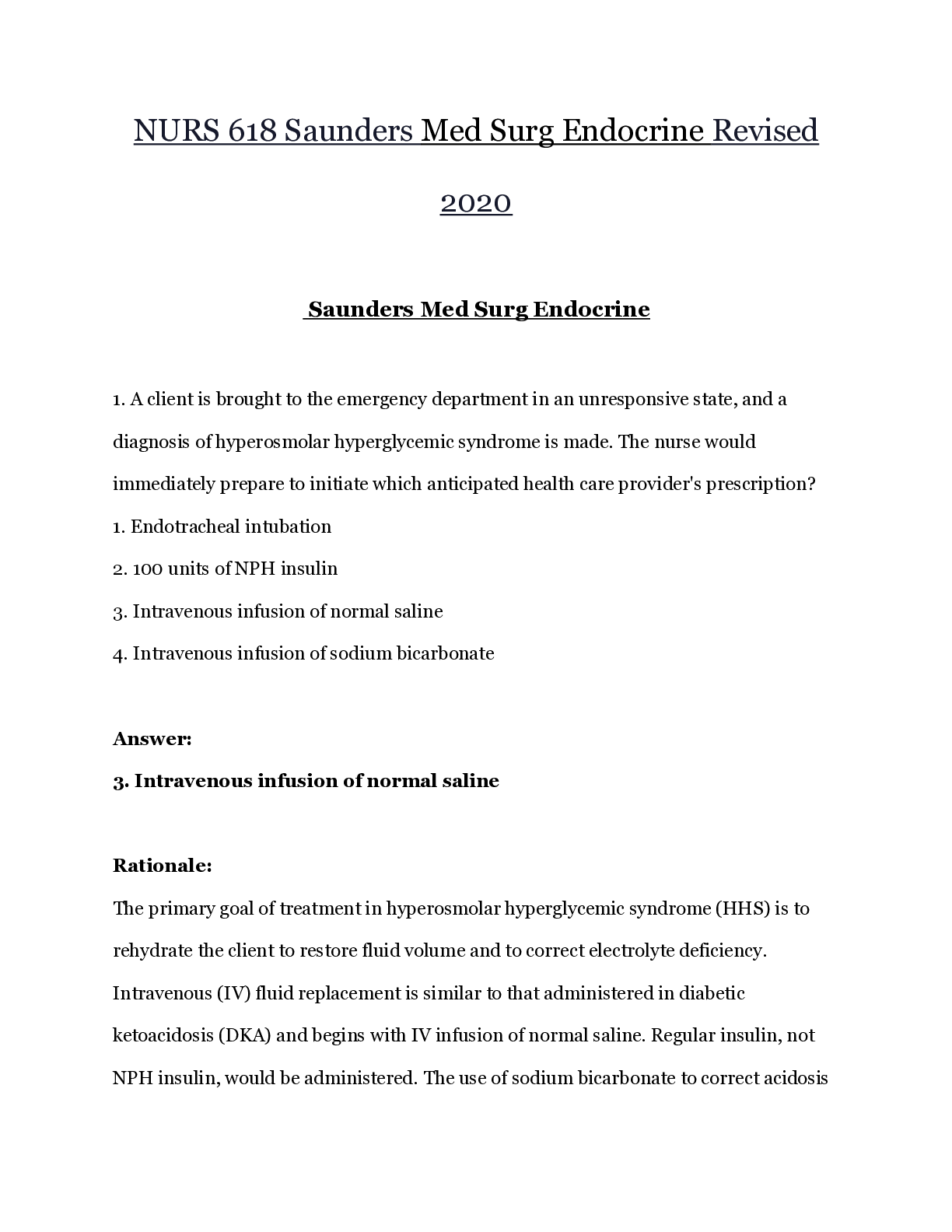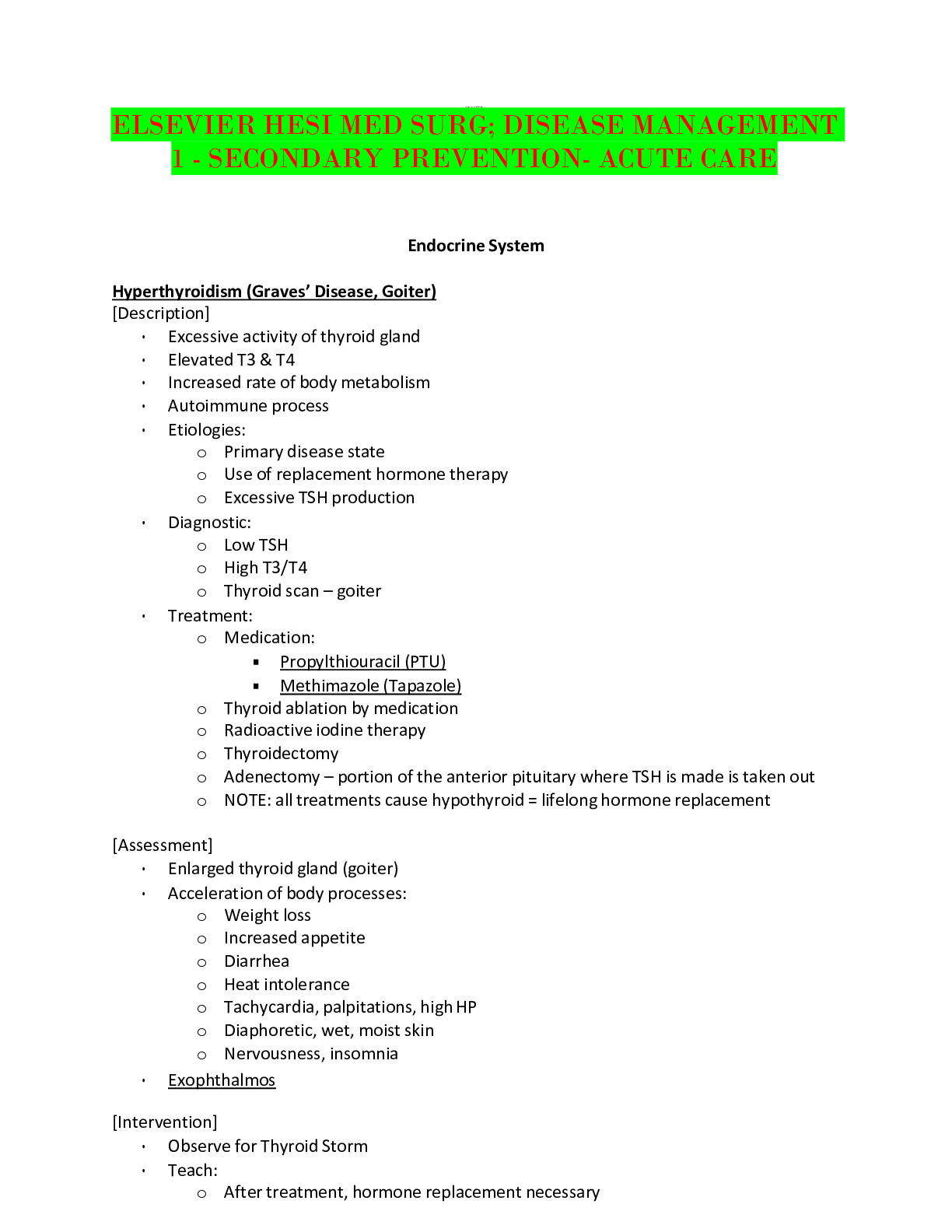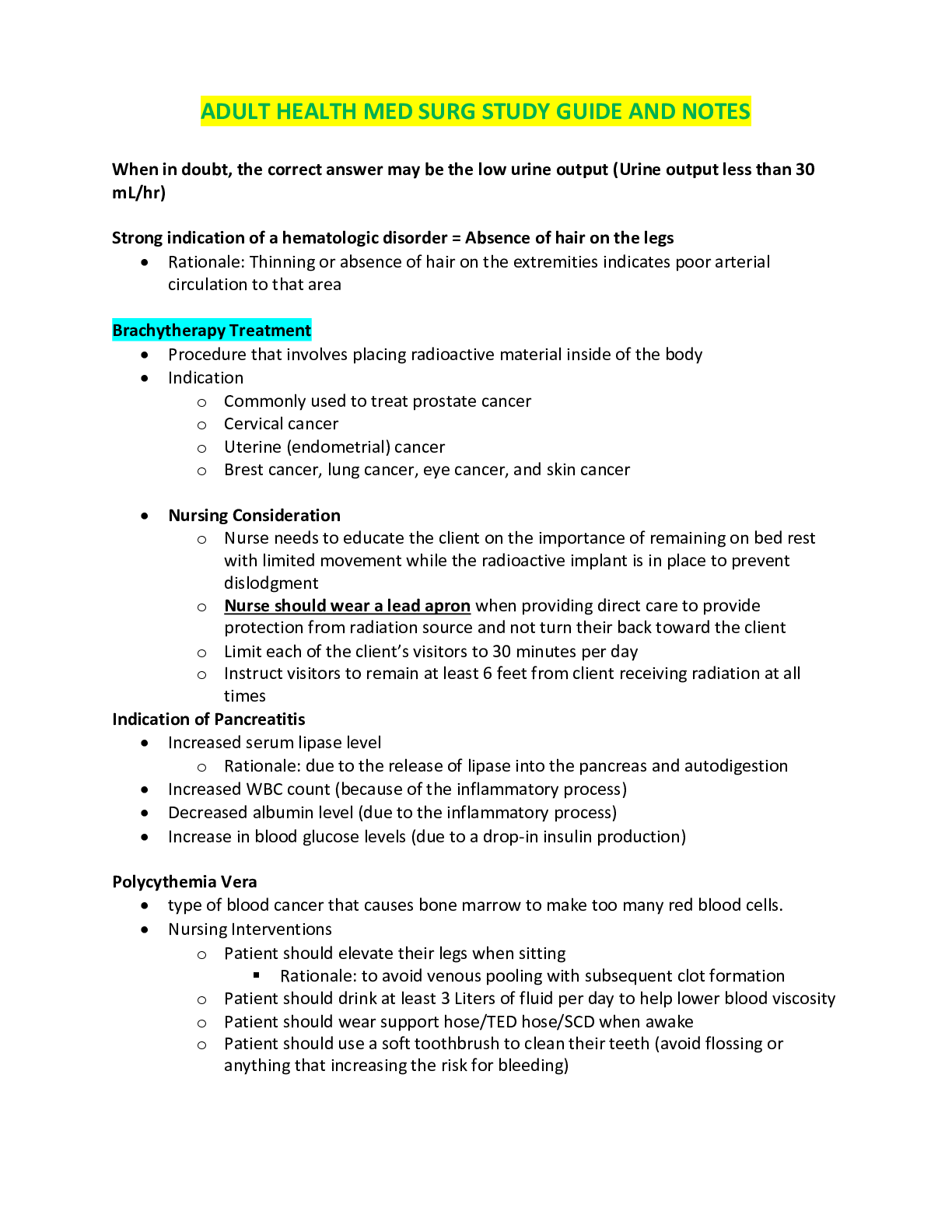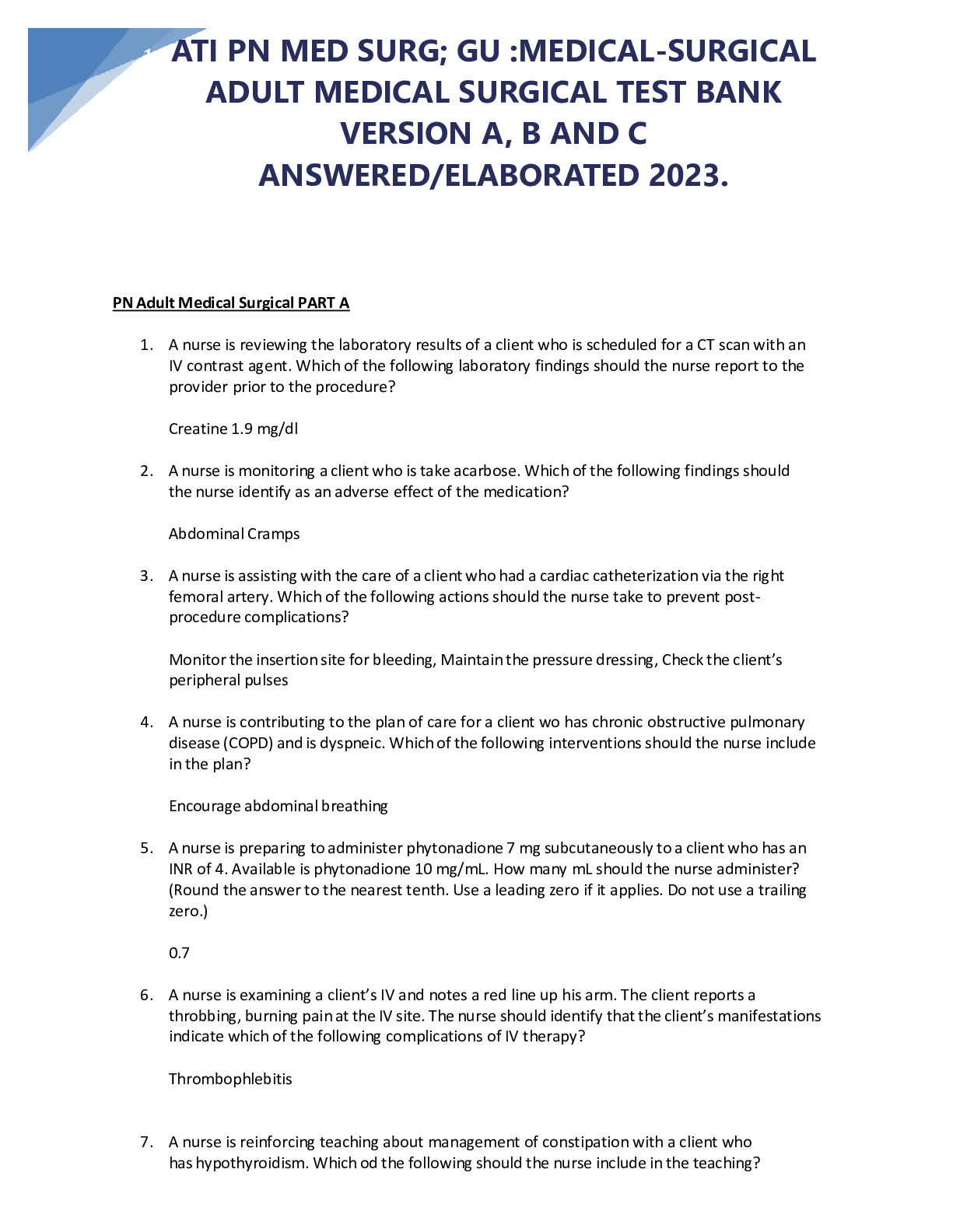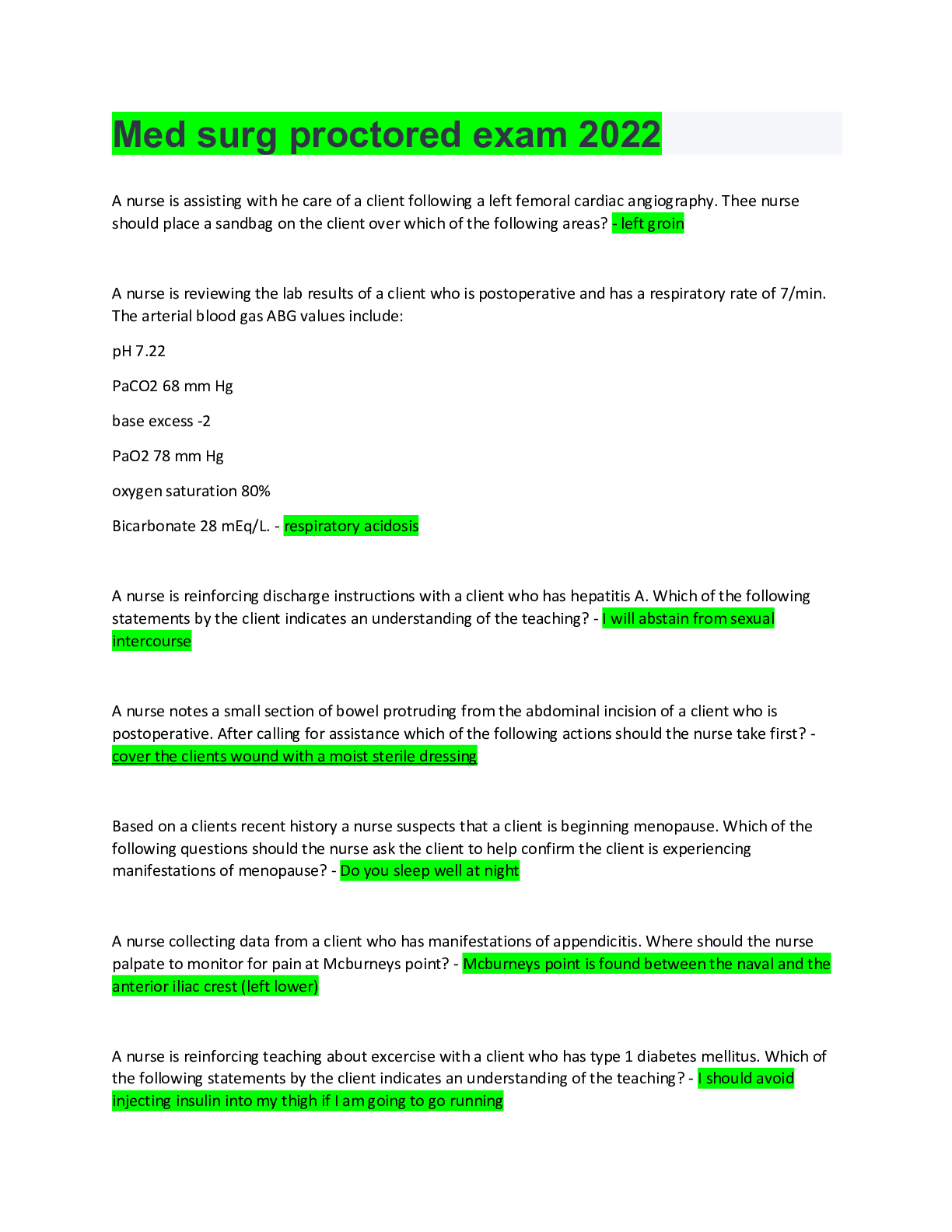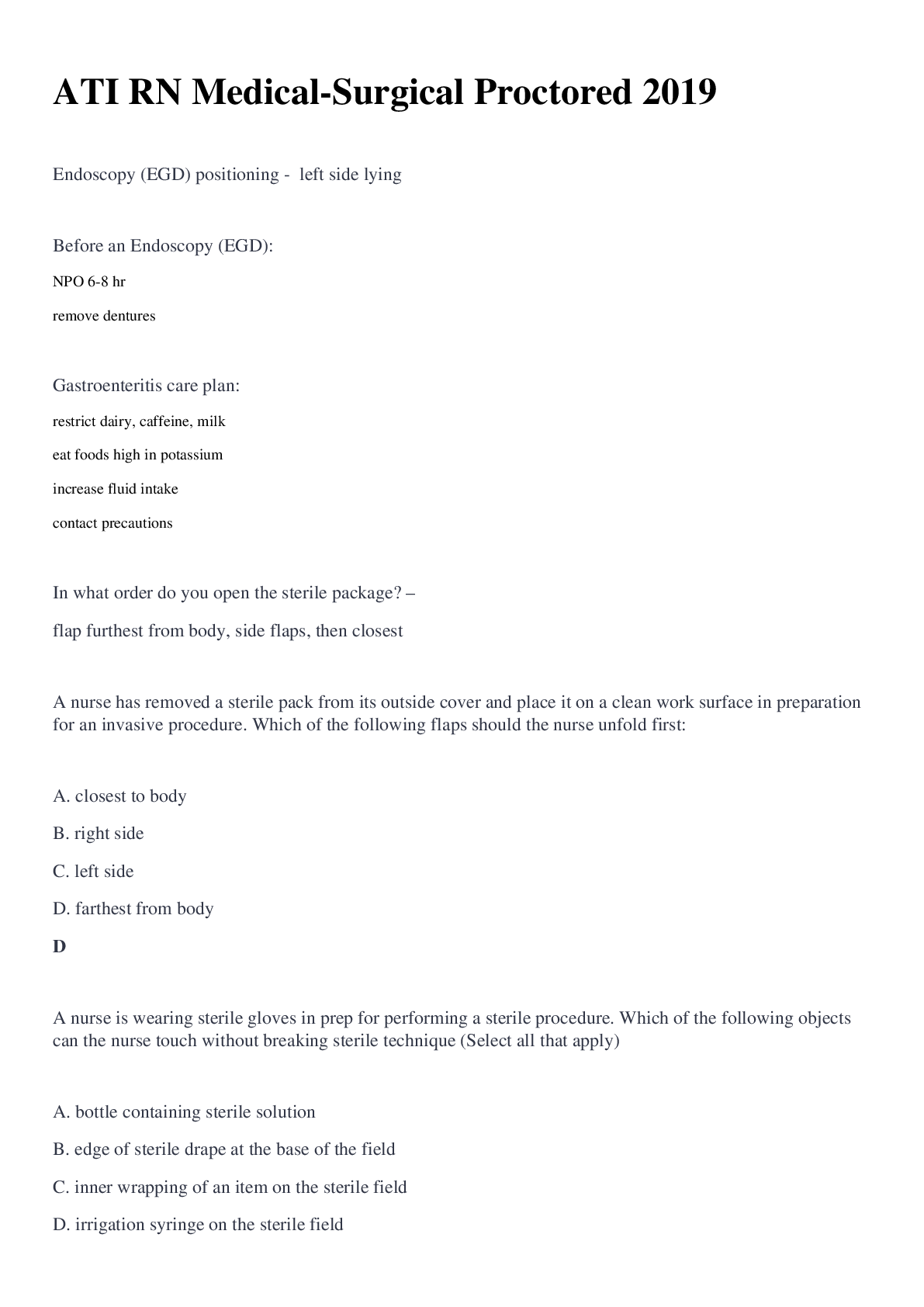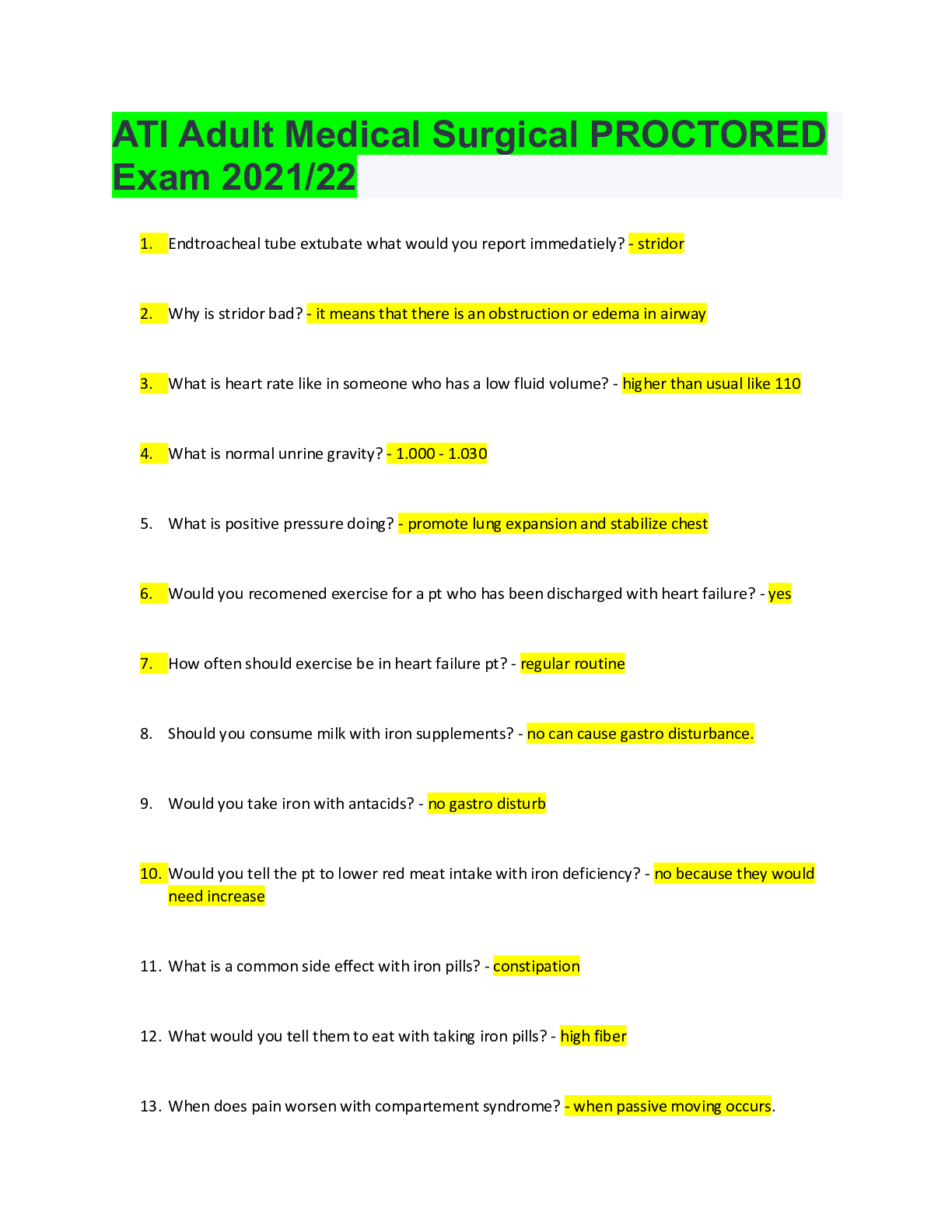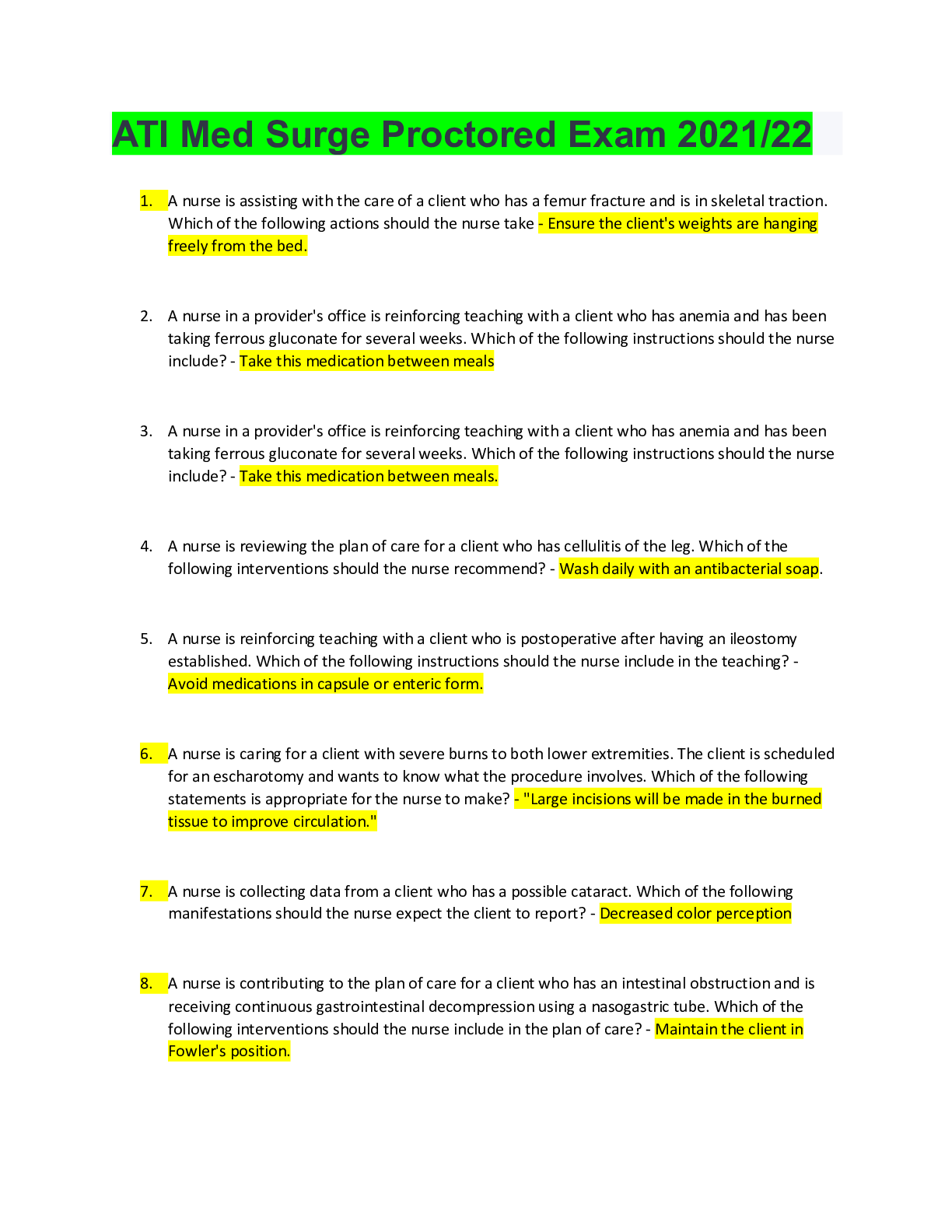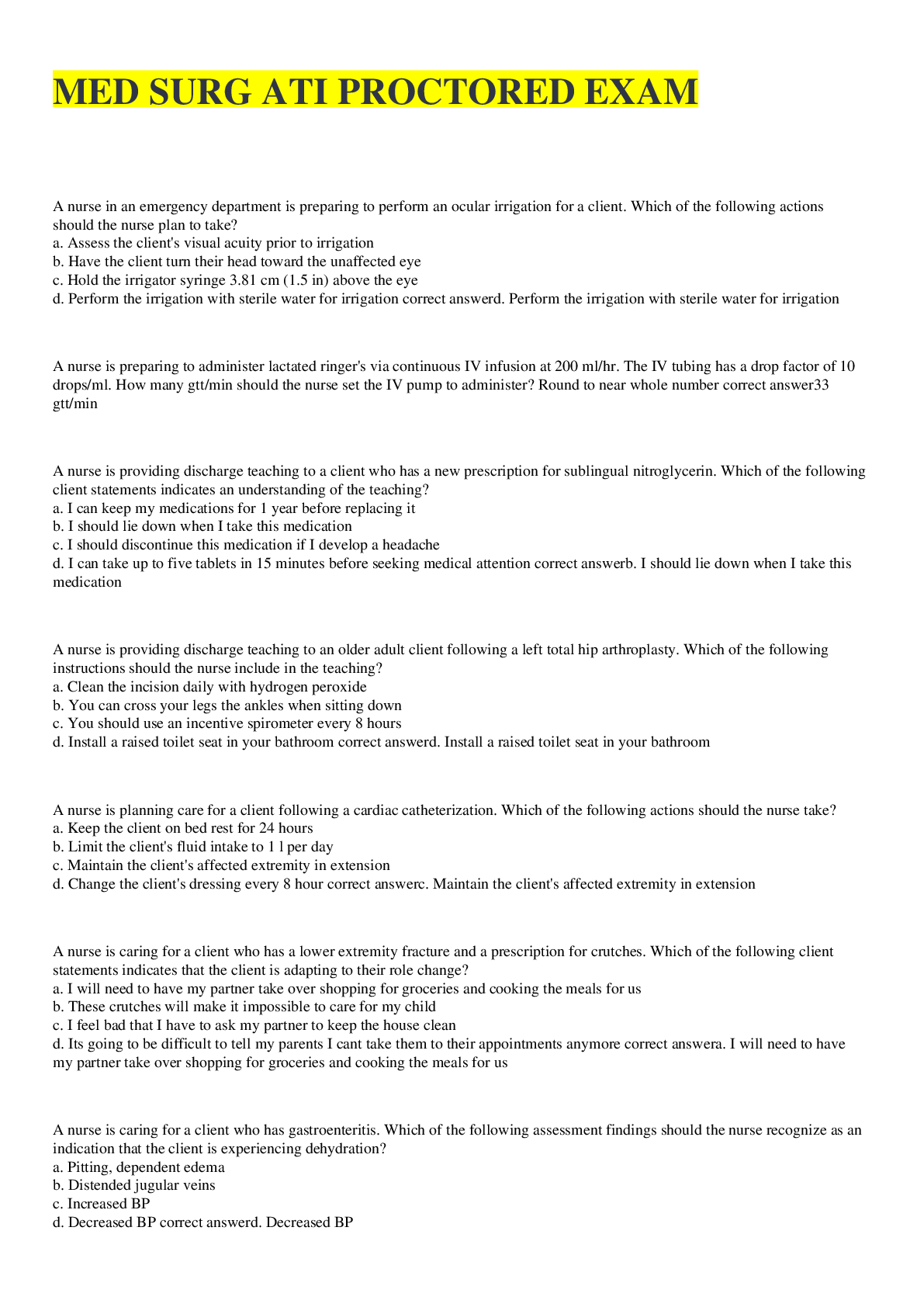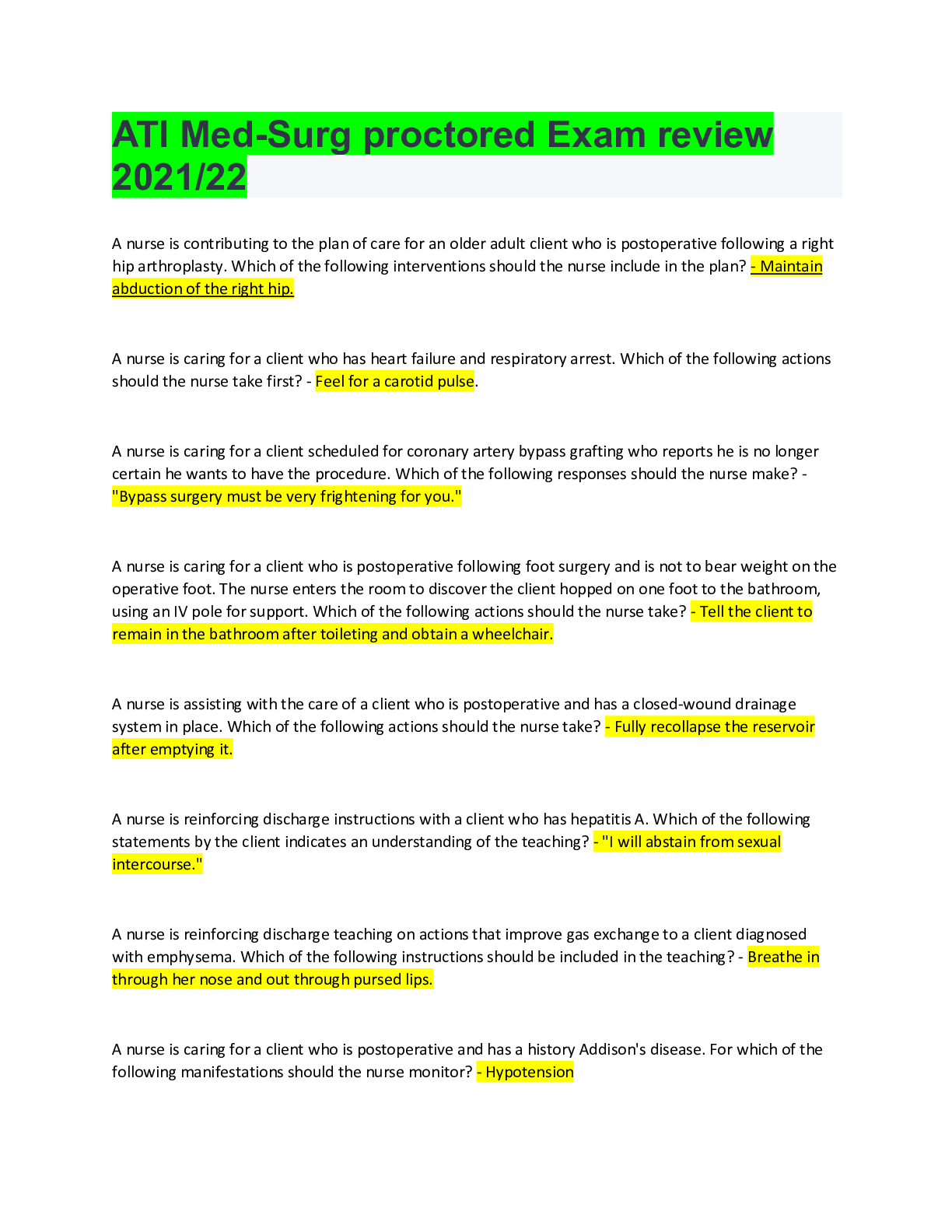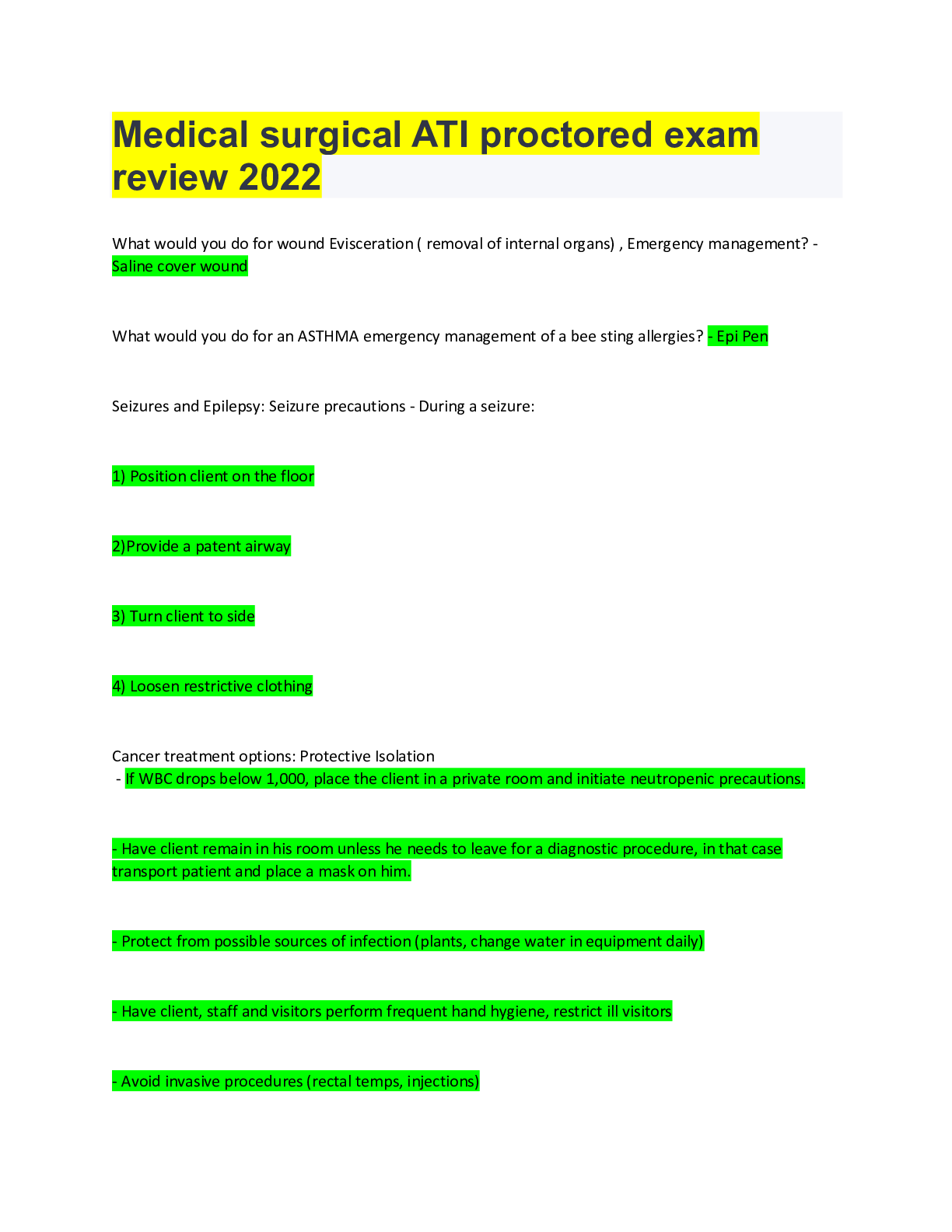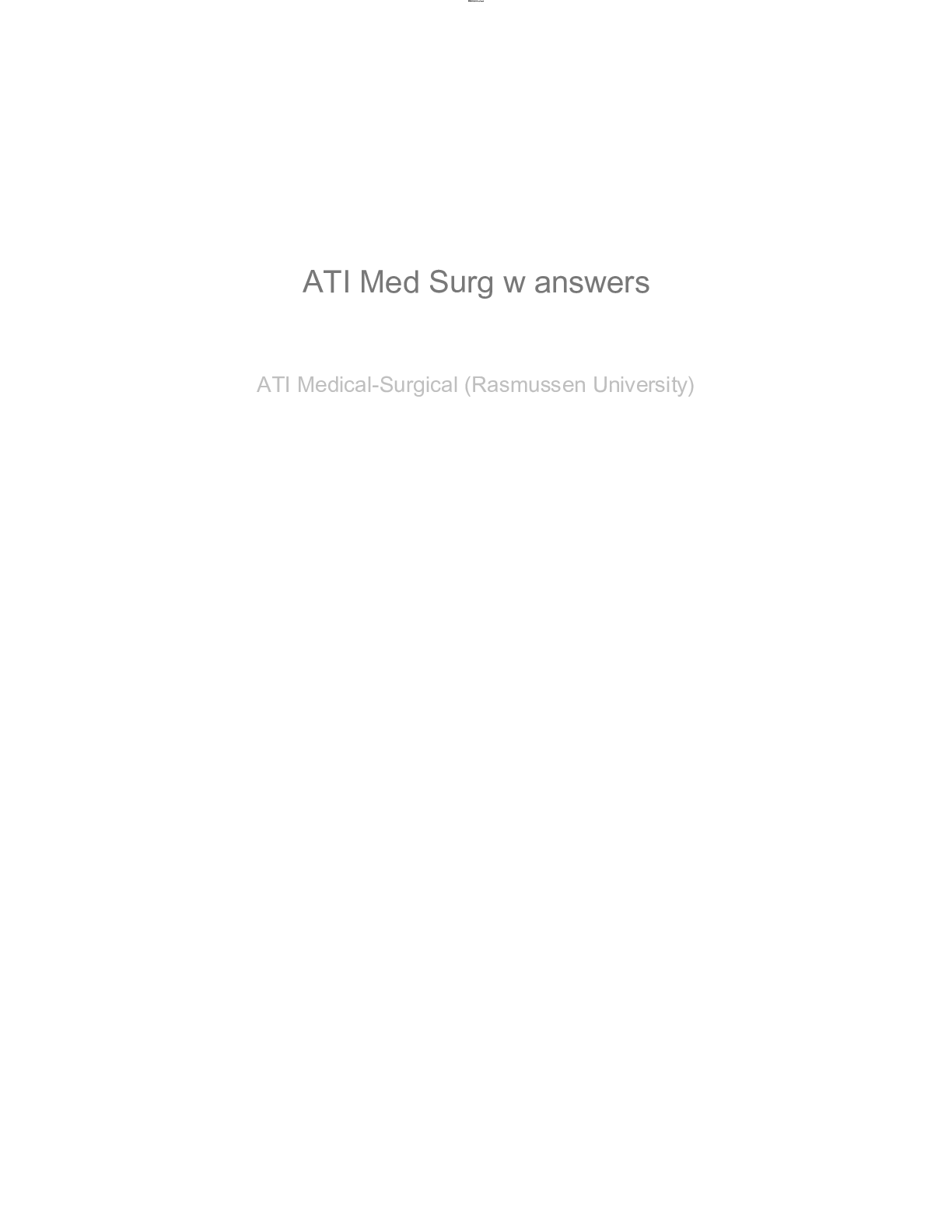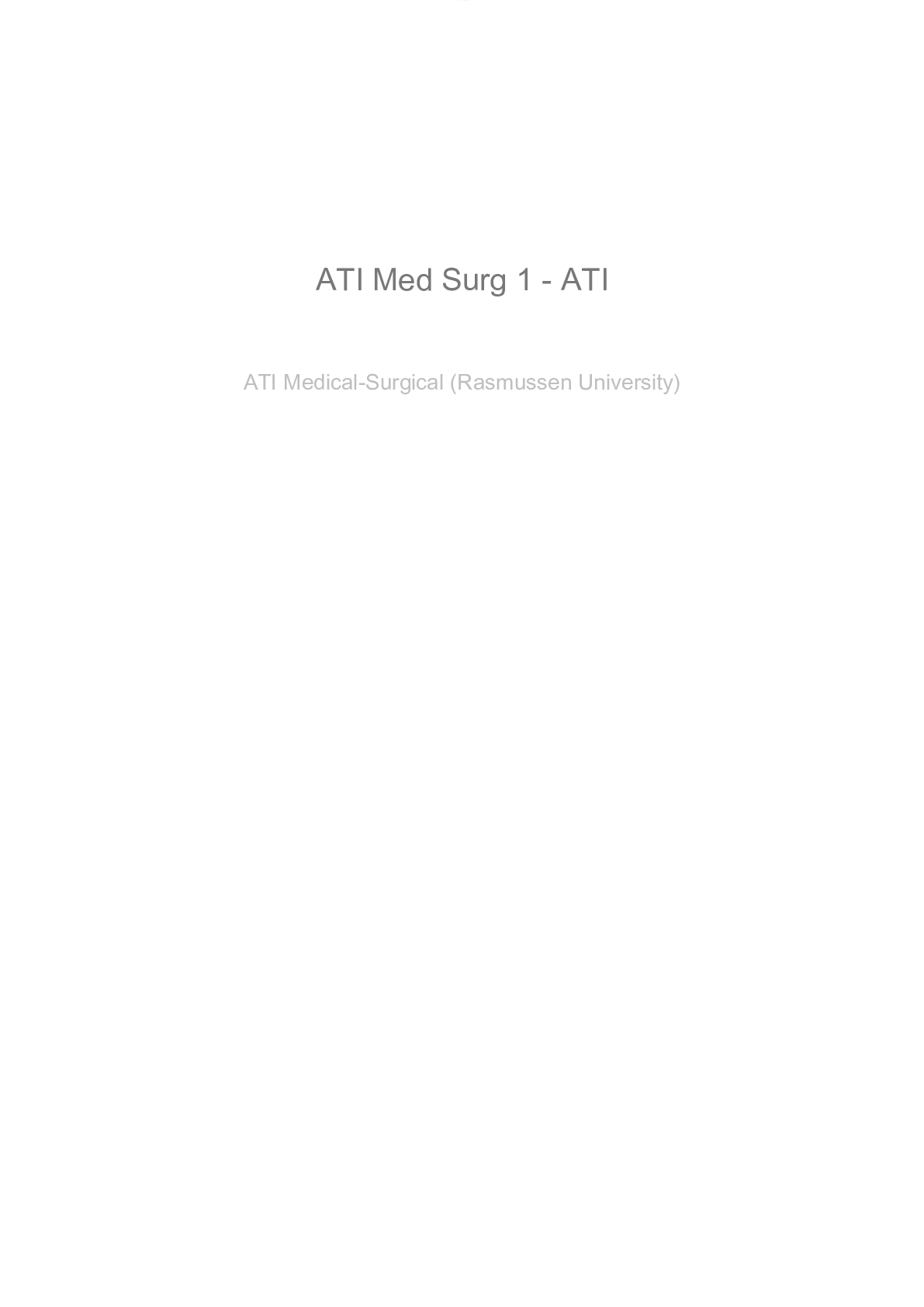*NURSING > MED-SURG EXAM > Med Surg Test bank (Red HESI Test bank Med-Surg and other resources) Questions with accurate answers (All)
Med Surg Test bank (Red HESI Test bank Med-Surg and other resources) Questions with accurate answers, rated A
Document Content and Description Below
Med Surg Test bank (Red HESI Test bank Med-Surg and other resources) Questions with accurate answers, rated A The nurse assesses a patient with shortness of breath for evidence of long-standing h... ypoxemia by inspecting: A. Chest excursion B. Spinal curvatures C. The respiratory pattern D. The fingernail and its base - ✔✔D. The fingernail and its base Clubbing, a sign of long-standing hypoxemia, is evidenced by an increase in the angle between the base of the nail and the fingernail to 180 degrees or more, usually accompanied by an increase in the depth, bulk, and sponginess of the end of the finger. 2. The nurse is caring for a patient with COPD and pneumonia who has an order for arterial blood gases to be drawn. Which of the following is the minimum length of time the nurse should plan to hold pressure on the puncture site? A. 2 minutes B. 5 minutes C. 10 minutes D. 15 minutes - ✔✔B. 5 minutes Following obtaining an arterial blood gas, the nurse should hold pressure on the puncture site for 5 minutes by the clock to be sure that bleeding has stopped. An artery is an elastic vessel under higher pressure than veins, and significant blood loss or hematoma formation could occur if the time is insufficient. 3. The nurse notices clear nasal drainage in a patient newly admitted with facial trauma, including a nasal fracture. The nurse should: A. test the drainage for the presence of glucose. B. suction the nose to maintain airway clearance. C. document the findings and continue monitoring. D. apply a drip pad and reassure the patient this is normal. - ✔✔A. test the drainage for the presence of glucose. Clear nasal drainage suggests leakage of cerebrospinal fluid (CSF). The drainage should be tested for the presence of glucose, which would indicate the presence of CSF. 4. When caring for a patient who is 3 hours postoperative laryngectomy, the nurse's highest priority assessment would be: A. Airway patency B. Patient comfort C. Incisional drainage D. Blood pressure and heart rate - ✔✔A. Airway patency Remember ABCs with prioritization. Airway patency is always the highest priority and is essential for a patient undergoing surgery surrounding the upper respiratory system. 5. When initially teaching a patient the supraglottic swallow following a radical neck dissection, with which of the following foods should the nurse begin? A. Cola B. Applesauce C. French fries D. White grape juice - ✔✔A. ColaWhen learning the supraglottic swallow, it may be helpful to start with carbonated beverages because the effervescence provides clues about the liquid's position. Thin, watery fluids should be avoided because they are difficult to swallow and increase the risk of aspiration. Nonpourable pureed foods, such as applesauce, would decrease the risk of aspiration, but carbonated beverages are the better choice to start with. 6. The nurse is caring for a patient admitted to the hospital with pneumonia. Upon assessment, the nurse notes a temperature of 101.4° F, a productive cough with yellow sputum and a respiratory rate of 20. Which of the following nursing diagnosis is most appropriate based upon this assessment? A. Hyperthermia related to infectious illness B. Ineffective thermoregulation related to chilling C. Ineffective breathing pattern related to pneumonia D. Ineffective airway clearance related to thick secretions - ✔✔A. Hyperthermia related to infectious illness Because the patient has spiked a temperature and has a diagnosis of pneumonia, the logical nursing diagnosis is hyperthermia related to infectious illness. There is no evidence of a chill, and her breathing pattern is within normal limits at 20 breaths per minute. There is no evidence of ineffective airway clearance from the information given because the patient is expectorating sputum. 7. Which of the following physical assessment findings in a patient with pneumonia best supports the nursing diagnosis of ineffective airway clearance? A. Oxygen saturation of 85% B. Respiratory rate of 28 C. Presence of greenish sputum D. Basilar crackles - ✔✔D. Basilar crackles The presence of adventitious breath sounds indicates that there is accumulation of secretions in the lower airways. This would be consistent with a nursing diagnosis of ineffective airway clearance because the patient is retaining secretions. 8. Which of the following clinical manifestations would the nurse expect to find during assessment of a patient admitted with pneumococcal pneumonia? A. Hyperresonance on percussion B. Fine crackles in all lobes on auscultation C. Increased vocal fremitus on palpation D. Vesicular breath sounds in all lobes - ✔✔C. Increased vocal fremitus on palpation. A typical physical examination finding for a patient with pneumonia is increased vocal fremitus on palpation. Other signs of pulmonary consolidation include dullness to percussion, bronchial breath sounds, and crackles in the affected area. 9. Which of the following nursing interventions is of the highest priority in helping a patient expectorate thick secretions related to pneumonia? A. Humidify the oxygen as able B. Increase fluid intake to 3L/day if tolerated. C. Administer cough suppressant q4hr. D. Teach patient to splint the affected area. - ✔✔B. Increase fluid intake to 3L/day if tolerated. Although several interventions may help the patient expectorate mucus, the highest priority should be on increasing fluid intake, which will liquefy the secretions so that the patient can expectorate them more easily. Humidifying the oxygen is also helpful, but is not the primary intervention. Teaching the patient to splint the affected area may also be helpful, but does not liquefy the secretions so that they can be removed. 10. During discharge teaching for a 65-year-old patient with emphysema and pneumonia, which of the following vaccines should the nurse recommend the patient receive? A. S. aureus B. H. influenzae C. Pneumococcal D. Bacille Calmette-Guérin (BCG) - ✔✔C. Pneumococcal The pneumococcal vaccine is important for patients with a history of heart or lung disease, recovering from a severe illness, age 65 or over, or living in a long-term care facility. 11. The nurse evaluates that discharge teaching for a patient hospitalized with pneumonia has been most effective when the patient states which of the following measures to prevent a relapse? A. "I will increase my food intake to 2400 calories a day to keep my immune system well." B. "I must use home oxygen therapy for 3 months and then will have a chest x-ray to reevaluate." C. "I will seek immediate medical treatment for any upper respiratory infections." D. "I should continue to do deep-breathing and coughing exercises for at least 6 weeks." - ✔✔D. "I should continue to do deep-breathing and coughing exercises for at least 6 weeks." It is important for the patient to continue with coughing and deep breathing exercises for 6 to 8 weeks until all of the infection has cleared from the lungs. A patient should seek medical treatment for upper respiratory infections that persist for more than 7 days. Increased fluid intake, not caloric intake, is required to liquefy secretions. Home O2 is not a requirement unless the patient's oxygenation saturation is below normal. 12. After admitting a patient to the medical unit with a diagnosis of pneumonia, the nurse will verify that which of the following physician orders have been completed before administering a dose of cefotetan (Cefotan) to the patient? A. Serum laboratory studies ordered for AM B. Pulmonary function evaluation C. Orthostatic blood pressures D. Sputum culture and sensitivity - ✔✔D. Sputum culture and sensitivityThe nurse should ensure that the sputum for culture and sensitivity was sent to the laboratory before administering the cefotetan. It is important that the organisms are correctly identified (by the culture) before their numbers are affected by the antibiotic; the test will also determine whether the proper antibiotic has been ordered (sensitivity testing). Although antibiotic administration should not be unduly delayed while waiting for the patient to expectorate sputum, all of the other options will not be affected by the administration of antibiotics. 13. Which of the following nursing interventions is most appropriate to enhance oxygenation in a patient with unilateral malignant lung disease? A. Positioning patient on right side. B. Maintaining adequate fluid intake C. Performing postural drainage every 4 hours D. Positioning patient with "good lung down" - ✔✔D. Positioning patient with "good lung down" Therapeutic positioning identifies the best position for the patient assuring stable oxygenation status. Research indicates that positioning the patient with the unaffected lung (good lung) dependent best promotes oxygenation in patients with unilateral lung disease. For bilateral lung disease, the right lung down has best ventilation and perfusion. Increasing fluid intake and performing postural drainage will facilitate airway clearance, but positioning is most appropriate to enhance oxygenation. 14. A 71-year-old patient is admitted with acute respiratory distress related to cor pulmonale. Which of the following nursing interventions is most appropriate during admission of this patient? A. Delay any physical assessment of the patient and review with the family the patient's history of respiratory problems. B. Perform a comprehensive health history with the patient to review prior respiratory problems. C. Perform a physical assessment of the respiratory system and ask specific questions related to this episode of respiratory distress. D. Complete a full physical examination to determine the effect of the respiratory distress on other body functions. - ✔✔C. Perform a physical assessment of the respiratory system and ask specific questions related to this episode of respiratory distress.Because the patient is having respiratory difficulty, the nurse should ask specific questions about this episode and perform a physical assessment of this system. Further history taking and physical examination of other body systems can proceed once the patient's acute respiratory distress is being managed. 15. When planning appropriate nursing interventions for a patient with metastatic lung cancer and a 60-pack-year history of cigarette smoking, the nurse recognizes that the smoking has most likely decreased the patient's underlying respiratory defenses because of impairment of which of the following? A. Reflex bronchoconstriction B. Ability to filter particles from the air C. Cough reflex D. Mucociliary clearance - ✔✔D. Mucociliary clearance Smoking decreases the ciliary action in the tracheobronchial tree, resulting in impaired clearance of respiratory secretions, chronic cough, and frequent respiratory infections. 16. While ambulating a patient with metastatic lung cancer, the nurse observes a drop in oxygen saturation from 93% to 86%. Which of the following nursing interventions is most appropriate based upon these findings? A. Continue with ambulation as this is a normal response to activity. B. Move the oximetry probe from the finger to the earlobe for more accurate monitoring during activity. C. Obtain a physician's order for supplemental oxygen to be used during ambulation and other activity. D. Obtain a physician's order for arterial blood gas determinations to verify the oxygen saturation. - ✔✔C. Obtain a physician's order for supplemental oxygen to be used during ambulation and other activity. An oxygen saturation level that drops below 90% with activity indicates that the patient is not tolerating the exercise and needs to have supplemental oxygen applied. 17. The nurse is caring for a 73-year-old patient who underwent a left total knee arthroplasty. On the third postoperative day, the patient complains of shortness of breath, slight chest pain, and that "something is wrong." Temperature is 98.4o F, blood pressure 130/88, respirations 36, and oxygen saturation 91% on room air. Which of the following should the nurse first suspect as the etiology of this episode? A. Septic embolus from the knee joint B. Pulmonary embolus from deep vein thrombosis C. New onset of angina pectoris D. Pleural effusion related to positioning in the operating room - ✔✔B. Pulmonary embolus from deep vein thrombosis The patient presents the classic symptoms of pulmonary embolus: acute onset of symptoms, tachypnea, shortness of breath, and chest pain. 18. In the case of pulmonary embolus from deep vein thrombosis, which of the following actions should the nurse take first? A. Notify the physician. B. Administer a nitroglycerin tablet sublingually. C. Conduct a thorough assessment of the chest pain. D. Sit the patient up in bed as tolerated and apply oxygen. - ✔✔D. Sit the patient up in bed as tolerated and apply oxygen.The patient's clinical picture is consistent with pulmonary embolus, and the first action the nurse takes should be to assist the patient. For this reason, the nurse should sit the patient up as tolerated and apply oxygen before notifying the physician. 19. The nurse is caring for a postoperative patient with sudden onset of respiratory distress. The physician orders a STAT ventilation-perfusion scan. Which of the following explanations should the nurse provide to the patient about the procedure? A. This test involves injection of a radioisotope to outline the blood vessels in the lungs, followed by inhalation of a radioisotope gas. B. This test will use special technology to examine cross sections of the chest with use of a contrast dye. C. This test will use magnetic fields to produce images of the lungs and chest. D. This test involves injecting contrast dye into a blood vessel to outline the blood vessels of the lungs. - ✔✔A. This test involves injection of a radioisotope to outline the blood vessels in the lungs, followed by inhalation of a radioisotope gas.A ventilation-perfusion scan has two parts. In the perfusion portion, a radioisotope is injected into the blood and the pulmonary vasculature is outlined. In the ventilation part, the patient inhales a radioactive gas that outlines the alveoli. 20. During assessment of a 45-year-old patient with asthma, the nurse notes wheezing and dyspnea. The nurse interprets that these symptoms are related to which of the following pathophysiologic changes? A. Laryngospasm B. Overdistention of the alveoli C. Narrowing of the airway D. Pulmonary edema - ✔✔C. Narrowing of the airwayNarrowing of the airway leads to reduced airflow, making it difficult for the patient to breathe and producing the characteristic wheezing. 21. A 45-year-old man with asthma is brought to the emergency department by automobile. He is short of breath and appears frightened. During the initial nursing assessment, which of the following clinical manifestations might be present as an early symptom during an exacerbation of asthma? A. Anxiety B. Cyanosis C. Hypercapnia D. Bradycardia - ✔✔A. Anxiety An early symptom during an asthma attack is anxiety because he is acutely aware of the inability to get sufficient air to breathe. He will be hypoxic early on with decreased PaCO2 and increased pH as he is hyperventilating. 22. The nurse is assigned to care for a patient who has anxiety and an exacerbation of asthma. Which of the following is the primary reason for the nurse to carefully inspect the chest wall of this patient? A. Observe for signs of diaphoresis B. Allow time to calm the patient C. Monitor the patient for bilateral chest expansion D. Evaluate the use of intercostal muscles - ✔✔D. Evaluate the use of intercostal muscles The nurse physically inspects the chest wall to evaluate the use of intercostal (accessory) muscles, which gives an indication of the degree of respiratory distress experienced by the patient. 23. Which of the following positions is most appropriate for the nurse to place a patient experiencing an asthma exacerbation? A. Supine B. Lithotomy C. High-Fowler's D. Reverse Trendelenburg - ✔✔C. High-Fowler'sThe patient experiencing an asthma attack should be placed in high-Fowler's position to allow for optimal chest expansion and enlist the aid of gravity during inspiration. 24. The nurse is caring for a patient with an acute exacerbation of asthma. Following initial treatment, which of the following findings indicates to the nurse that the patient's respiratory status is improving? A. Wheezing becomes louder B. Vesicular breath sounds decrease C. Aerosol bronchodilators stimulate coughing D. The cough remains nonproductive - ✔✔A. Wheezing becomes louder The primary problem during an exacerbation of asthma is narrowing of the airway and subsequent diminished air exchange. As the airways begin to dilate, wheezing gets louder because of better air exchange. 25. The nurse identifies the nursing diagnosis of activity intolerance for a patient with asthma. The nurse assesses for which of the following etiologic factor for this nursing diagnosis in patients with asthma? A. Anxiety and restlessness B. Effects of medications C. Fear of suffocation D. Work of breathing - ✔✔D. Work of breathingWhen the patient does not have sufficient gas exchange to engage in activity, the etiologic factor is often the work of breathing. When patients with asthma do not have effective respirations, they use all available energy to breathe and have little left over for purposeful activity. 26. The nurse is assigned to care for a patient in the emergency department admitted with an exacerbation of asthma. The patient has received a β-adrenergic bronchodilator and supplemental oxygen. If the patient's condition does not improve, the nurse should anticipate which of the following is likely to be the next step in treatment? A. Pulmonary function testing B. Systemic corticosteroids C. Biofeedback therapy D. Intravenous fluids - ✔✔B. Systemic corticosteroids Systemic corticosteroids speed the resolution of asthma exacerbations and are indicated if the initial response to the β-adrenergic bronchodilator is insufficient. 27. A patient with acute exacerbation of COPD needs to receive precise amounts of oxygen. Which of the following types of equipment should the nurse prepare to use? A. Venturi mask B. Partial non-rebreather mask C. Oxygen tent D. Nasal cannula - ✔✔A. Venturi mask The Venturi mask delivers precise concentrations of oxygen and should be selected whenever this is a priority concern. The other methods are less precise in terms of amount of oxygen delivered. 28. While teaching a patient with asthma about the appropriate use of a peak flow meter, the nurse instructs the patient to do which of the following? A. Use the flow meter each morning after taking medications to evaluate their effectiveness. B. Empty the lungs and then inhale quickly through the mouthpiece to measure how fast air can be inhaled. C. Keep a record of the peak flow meter numbers if symptoms of asthma are getting worse. D. Increase the doses of the long-term control medication if the peak flow numbers decrease. - ✔✔C. Keep a record of the peak flow meter numbers if symptoms of asthma are getting worse. It is important to keep track of peak flow readings daily and when the patient's symptoms are getting worse. The patient should have specific directions as to when to call the physician based on personal peak flow numbers. Peak flow is measured by exhaling into the meters and should be assessed before and after medications to evaluate their effectiveness. 29. The physician has prescribed salmeterol (Serevent) for a patient with asthma. In reviewing the use of dry powder inhalers (DPIs) with the patient, the nurse should provide which of the following instructions? A. "Close lips tightly around the mouthpiece and breathe in deeply and quickly." B. "To administer a DPI, you must use a spacer that holds the medicine so that you can inhale it." C. "Hold the inhaler several inches in front of your mouth and breathe in slowly, holding the medicine as long as possible." D. "You will know you have correctly used the DPI when you taste or sense the medicine going into your lungs." - ✔✔A. "Close lips tightly around the mouthpiece and breathe in deeply and quickly." Dry powder inhalers do not require spacer devices. The patient should be instructed to breathe in deeply and quickly to ensure medicine moves down deeply into lungs. The patient may not taste or sense the medicine going into the lungs. 30. The nurse determines that a patient is experiencing common adverse effects from the inhaled corticosteroid beclomethasone (Beclovent) after noting which of the following? A. Adrenocortical dysfunction and hyperglycemia B. Elevation of blood glucose and calcium levels C. Oropharyngeal candidiasis and hoarseness D. Hypertension and pulmonary edema - ✔✔C. Oropharyngeal candidiasis and hoarseness Oropharyngeal candidiasis and hoarseness are common adverse effects from the use of inhaled corticosteroids because the medication can lead to overgrowth of organisms and local irritation if the patient does not rinse the mouth following each dose. 31. The nurse determines that the patient understood medication instructions about the use of a spacer device when taking inhaled medications after hearing the patient state which of the following as the primary benefit? A. "Now I will not need to breathe in as deeply when taking the inhaler medications." B. "This device will make it so much easier and faster to take my inhaled medications." C. "I will pay less for medication because it will last longer." D. "More of the medication will get down into my lungs to help my breathing." - ✔✔D. "More of the medication will get down into my lungs to help my breathing." A spacer assists more medication to reach the lungs, with less being deposited in the mouth and the back of the throat. 32. Which of the following test results identify that a patient with an asthma attack is responding to treatment? A. A decreased exhaled nitric oxide B. An increase in CO2 levels C. A decrease in white blood cell count D. An increase in serum bicarbonate levels - ✔✔A. A decreased exhaled nitric oxide. Nitric oxide levels are increased in the breath of people with asthma. A decrease in the exhaled nitric oxide concentration suggests that the treatment may be decreasing the lung inflammation associated with asthma. 33. The nurse determines that the patient is not experiencing adverse effects of albuterol (Proventil) after noting which of the following patient vital signs? A. Oxygen saturation 96% B. Respiratory rate of 18 C. Temperature of 98.4° F D. Pulse rate of 76 - ✔✔D. Pulse rate of 76 Albuterol is a β2-agonist that can sometimes cause adverse cardiovascular effects. These would include tachycardia and angina. A pulse rate of 76 indicates that the patient did not experience tachycardia as an adverse effect. 34. The patient has an order for each of the following inhalers. Which of the following should the nurse offer to the patient at the onset of an asthma attack? A. Albuterol (Proventil) B. Beclomethasone (Beclovent) C. Ipratropium bromide (Atrovent) D. Salmeterol (Serevent) - ✔✔A. Albuterol (Proventil) Albuterol is a short-acting bronchodilator that should initially be given when the patient experiences an asthma attack. 35. The nurse who has administered a first dose of oral prednisone (Deltasone) to the patient with asthma writes on the care plan to begin monitoring which of the following patient parameters? A. Intake and output B. Bowel sounds C. Apical pulse D. Deep tendon reflexes - ✔✔A. Intake and output Corticosteroids such as prednisone can lead to fluid retention. For this reason, it is important to monitor the patient's intake and output. 36. The nurse is assisting a patient to learn self-administration of beclomethasone two puffs inhalation q6hr. The nurse explains that the best way to prevent oral infection while taking this medication is to do which of the following as part of the self-administration techniques? A. Chew a hard candy before the first puff of medication. B. Ask for a breath mint following the second puff of medication. C. Rinse the mouth with water before each puff of medication. D. Rinse the mouth with water following the second puff of medication. - ✔✔D. Rinse the mouth with water following the second puff of medication. The patient should rinse the mouth with water following the second puff of medication to reduce the risk of fungal overgrowth and oral infection. 37. The nurse is scheduled to give a dose of salmeterol by metered dose inhaler (MDI). The nurse would administer the right drug by selecting the inhaler with which of the following trade names? A. Vanceril B. Serevent C. AeroBid D. Atrovent - ✔✔B. Serevent The trade or brand name for salmeterol, an adrenergic bronchodilator, is Serevent. 38. The nurse is evaluating whether a patient understands how to safely determine whether a metered dose inhaler is empty. The nurse interprets that the patient understands this important information to prevent medication underdosing when the patient describes which method to check the inhaler? A. Place it in water to see if it floats. B. Shake the canister while holding it next to the ear. C. Check the indicator line on the side of the canister. D. Keep track of the number of inhalations used. - ✔✔D. Keep track of the number of inhalations used. It is no longer appropriate to see if a canister floats in water or not as research has demonstrated this is not accurate. The best method to determine when to replace an inhaler is by knowing the maximum puffs available per MDI and then replacing when those inhalations have been used. 39. The nurse is scheduled to give a dose of ipratropium bromide by metered dose inhaler. The nurse would administer the right drug by selecting the inhaler with which of the following trade names? A. Vanceril B. Pulmicort C. AeroBid D. Atrovent - ✔✔D. Atrovent The trade or brand name for ipratropium bromide, an anticholinergic medication, is Atrovent. 40. The patient has an order for albuterol 5 mg via nebulizer. Available is a solution containing 2 mg/ml. How many milliliters should the nurse use to prepare the patient's dose? A. 0.2 B. 2.5 C. 3.75 D. 5.0 - ✔✔B. 2.5 41. When planning patient teaching about emphysema, the nurse understands that the symptoms of emphysema are caused by which of the following? A. Hypertrophy and hyperplasia of goblet cells in the bronchi B. Collapse and hypoventilation of the terminal respiratory unit C. An overproduction of the antiprotease alpha1-antitrypsin D. Hyperinflation of alveoli and destruction of alveolar walls - ✔✔D. Hyperinflation of alveoli and destruction of alveolar walls In emphysema, there are structural changes that include hyperinflation of alveoli, destruction of alveolar walls, destruction of alveolar capillary walls, narrowing of small airways, and loss of lung elasticity. 42. The patient has an order for albuterol 5 mg via nebulizer. Available is a solution containing 1 mg/ml. How many milliliters should the nurse use to prepare the patient's dose? A. 0.2 B. 2.5 C. 3.75 D. 5.0 - ✔✔D. 5.0 43. The nurse evaluates that nursing interventions to promote airway clearance in a patient admitted with COPD are successful based on which of the following findings? A. Absence of dyspnea B. Improved mental status C. Effective and productive coughing D. PaO2 within normal range for the patient - ✔✔C. Effective and productive coughing The issue of the question is airway clearance, which is most directly evaluated as successful if the patient can engage in effective and productive coughing. 44. When caring for a patient with COPD, the nurse identifies a nursing diagnosis of imbalanced nutrition less than body requirements after noting a weight loss of 30 lb. Which of the following would be an appropriate intervention to add to the plan of care for this patient? A. Teach the patient to use frozen meals at home that can be microwaved. B. Provide a high-calorie, high-carbohydrate, nonirritating, frequent feeding diet. C. Order fruits and fruit juices to be offered between meals. D. Order a high-calorie, high-protein diet with six small meals a day. - ✔✔D. Order a high-calorie, high-protein diet with six small meals a day.Because the patient with COPD needs to use greater energy to breathe, there is often decreased oral intake because of dyspnea. A full stomach also impairs the ability of the diaphragm to descend during inspiration, interfering with the work of breathing. Finally, the metabolism of a high carbohydrate diet yields large amounts of CO2, which may lead to acidosis in patients with pulmonary disease. For these reasons, the patient with emphysema should take in a high-calorie, high-protein diet, eating six small meals per day. 45. The nurse reviews pursed lip breathing with a patient newly diagnosed with emphysema. The nurse reinforces that this technique will assist respiration by which of the following mechanisms? A. Preventing bronchial collapse and air trapping in the lungs during exhalation B. Increasing the respiratory rate and giving the patient control of respiratory patterns C. Loosening secretions so that they may be coughed up more easily D. Promoting maximal inhalation for better oxygenation of the lungs - ✔✔A. Preventing bronchial collapse and air trapping in the lungs during exhalation The focus of pursed lip breathing is to slow down the exhalation phase of respiration, which decreases bronchial collapse and subsequent air trapping in the lungs during exhalation. 46. Nursing assessment findings of jugular vein distention and pedal edema would be indicative of which of the following complications of emphysema? A. Acute respiratory failure B. Pulmonary edema caused by left-sided heart failure C. Fluid volume excess secondary to cor pulmonale D. Secondary respiratory infection - ✔✔C. Fluid volume excess secondary to cor pulmonale Cor pulmonale is a right-sided heart failure caused by resistance to right ventricular outflow due to lung disease. With failure of the right ventricle, the blood emptying into the right atrium and ventricle would be slowed, leading to jugular venous distention and pedal edema. 47. A patient has been receiving oxygen per nasal cannula while hospitalized for COPD. The patient asks the nurse whether oxygen use will be needed at home. Which of the following would be the most appropriate response by the nurse? A. "Long-term home oxygen therapy should be used to prevent respiratory failure." B. "Oxygen will be needed when your oxygen saturation drops to 88% and you have symptoms of hypoxia. C. "Long-term home oxygen therapy should be used to prevent heart problems related to emphysema." D. "Oxygen will not be needed until or unless you are in the terminal stages of this disease." - ✔✔B. "Oxygen will be needed when your oxygen saturation drops to 88% and you have symptoms of hypoxia.Long-term oxygen therapy in the home should be considered when the oxygen saturation is 88% or less and the patient has signs of tissue hypoxia, such as cor pulmonale, erythrocytosis, or impaired mental status. 48. Before discharge, the nurse discusses activity levels with a 61-year-old patient with COPD and pneumonia. Which of the following exercise goals is most appropriate once the patient is fully recovered from this episode of illness? A. Slightly increase activity over the current level. B. Walk for 20 minutes a day, keeping the pulse rate less than 130 beats per minute. C. Limit exercise to activities of daily living to conserve energy. D. Swim for 10 min/day, gradually increasing to 30 min/day. - ✔✔B. Walk for 20 minutes a day, keeping the pulse rate less than 130 beats per minute. The patient will benefit from mild aerobic exercise that does not stress the cardiorespiratory system. The patient should be encouraged to walk for 20 min/day, keeping the pulse rate less than 75% to 80% of maximum heart rate (220 minus patient's age). 49. The nurse evaluates that a patient is experiencing the expected beneficial effects of ipratropium (Atrovent) after noting which of the following assessment findings? [Show More]
Last updated: 1 year ago
Preview 1 out of 94 pages
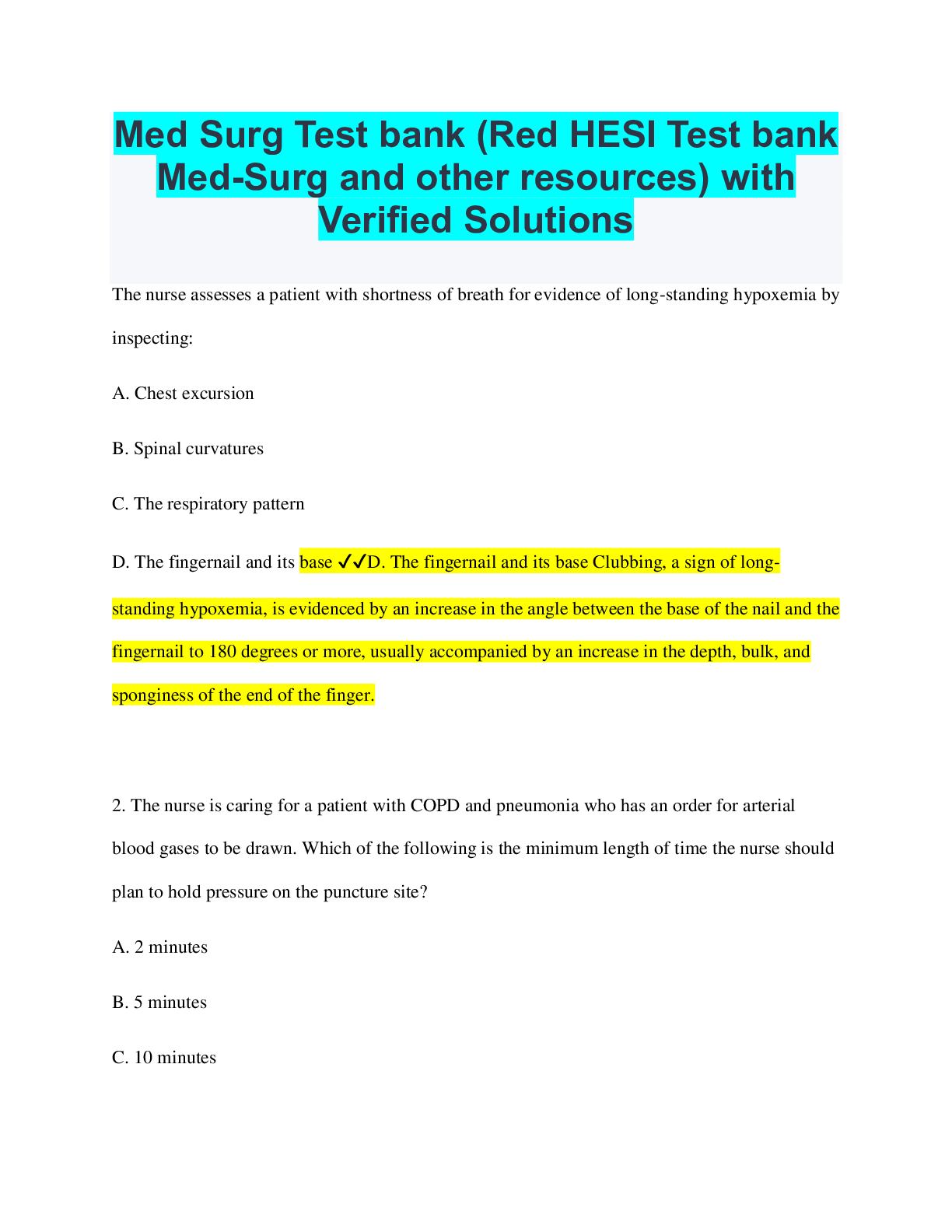
Reviews( 0 )
Document information
Connected school, study & course
About the document
Uploaded On
Oct 05, 2022
Number of pages
94
Written in
Additional information
This document has been written for:
Uploaded
Oct 05, 2022
Downloads
0
Views
91

